1. African Lion
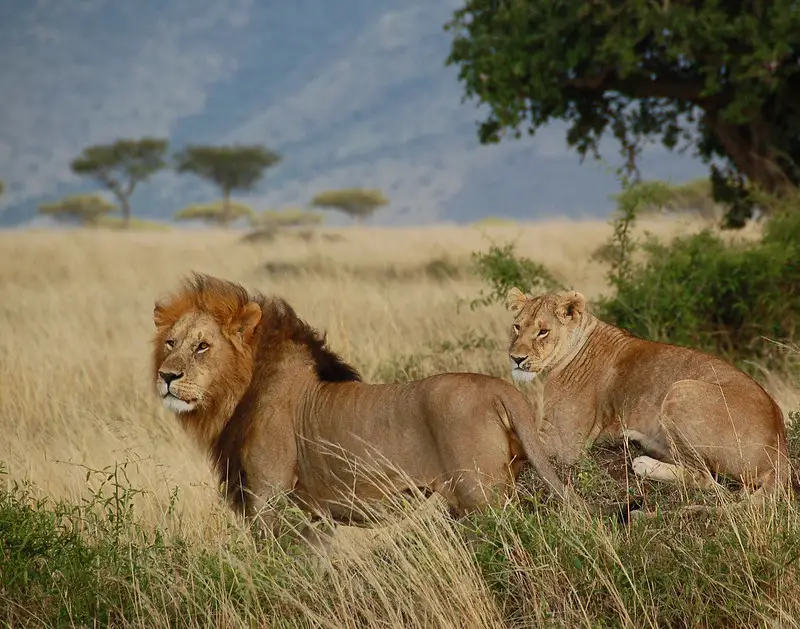
The African lion commands respect as the apex predator of the savanna. These powerful cats, weighing up to 550 pounds, dominate their territories with a roar that can be heard five miles away. Their iconic manes, growing up to 8 inches long, serve both as protection and a symbol of dominance. Lions are unique among big cats for their social structure, living in prides that work together to hunt and raise cubs.
Despite their fearsome reputation, lions face significant threats. Their population has plummeted by 43% in recent decades, with only about 20,000 remaining in the wild. Habitat loss, human conflict, and poaching have all taken their toll. Conservation efforts are crucial to ensure these magnificent creatures continue to rule the African plains. As apex predators, lions play a vital role in maintaining the delicate balance of their ecosystems.
2. Siberian Tiger
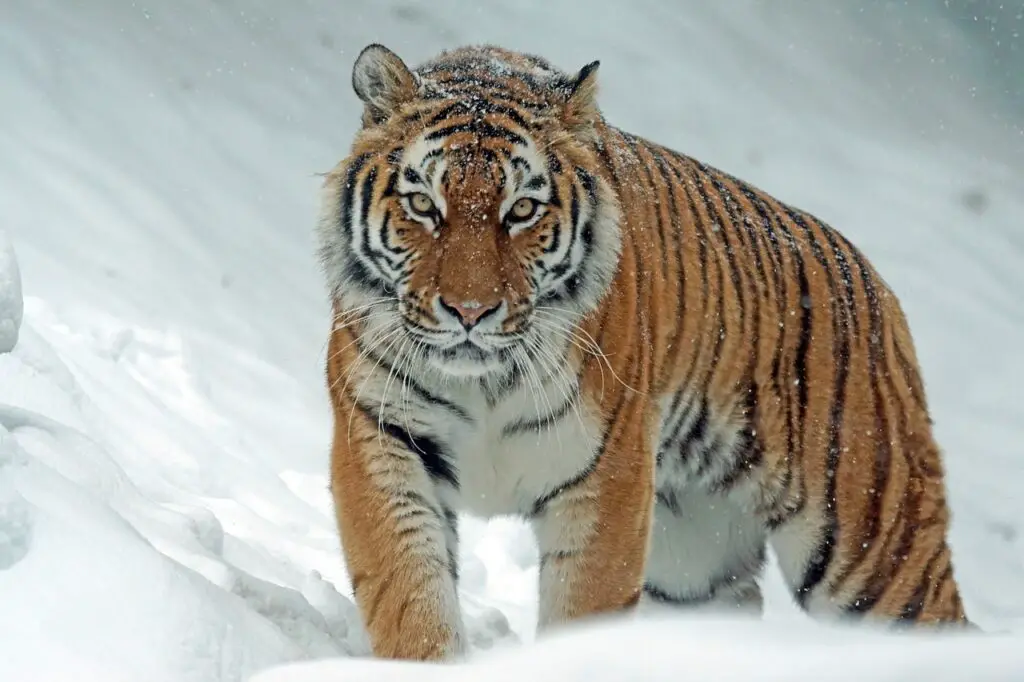
The Siberian tiger, largest of all wild cats, is a marvel of adaptation. Native to the Russian Far East, these tigers have evolved to thrive in extreme cold, with thick fur that can grow up to 2 inches long. A full-grown Siberian tiger can weigh up to 660 pounds and measure 11 feet from nose to tail. Their incredible strength allows them to take down prey as large as brown bears.
These solitary hunters roam vast territories, sometimes spanning 385 square miles. Their keen night vision and powerful legs make them formidable predators. Sadly, Siberian tigers are critically endangered, with only about 500 left in the wild. Habitat destruction and poaching pose the greatest threats to their survival. Conservation efforts focus on protecting their remaining habitat and cracking down on illegal hunting. The fate of these magnificent creatures hangs in the balance, highlighting the urgent need for continued protection.
3. Great White Shark

The great white shark is the ocean’s most feared predator, and for good reason. These massive fish can grow up to 20 feet long and weigh a staggering 5,000 pounds. Their streamlined bodies and powerful tails propel them through the water at speeds up to 35 mph, making them one of the fastest marine predators. Great whites are equipped with rows of serrated teeth, perfectly designed for tearing into prey.
These sharks have an incredible sense for detecting prey. They can smell a single drop of blood in 25 gallons of water and sense the tiny electromagnetic fields generated by animals. Despite their fearsome reputation, great whites are vulnerable to extinction. Overfishing, accidental capture, and the shark fin trade have reduced their numbers to fewer than 3,500 in the wild. As apex predators, their conservation is crucial for maintaining the health of marine ecosystems.
4. Killer Whale

Killer whales, or orcas, are the true wolves of the sea. Despite their name, they’re actually the largest member of the dolphin family, growing up to 32 feet long and weighing up to 22,000 pounds. Their distinctive black and white coloration isn’t just for show – it helps break up their outline in the water, making them stealthier hunters.
Orcas are incredibly intelligent and social, living in complex family groups called pods. Each pod has its own unique dialect of clicks, whistles, and pulsed calls. Their hunting techniques are diverse and often involve coordinated group efforts, allowing them to take down prey as large as great white sharks. While not globally endangered, some local populations face serious threats from pollution and habitat disturbance. The southern resident orcas of the Pacific Northwest, for example, have dwindled to just 75 individuals, highlighting the need for targeted conservation efforts.
5. Saltwater Crocodile
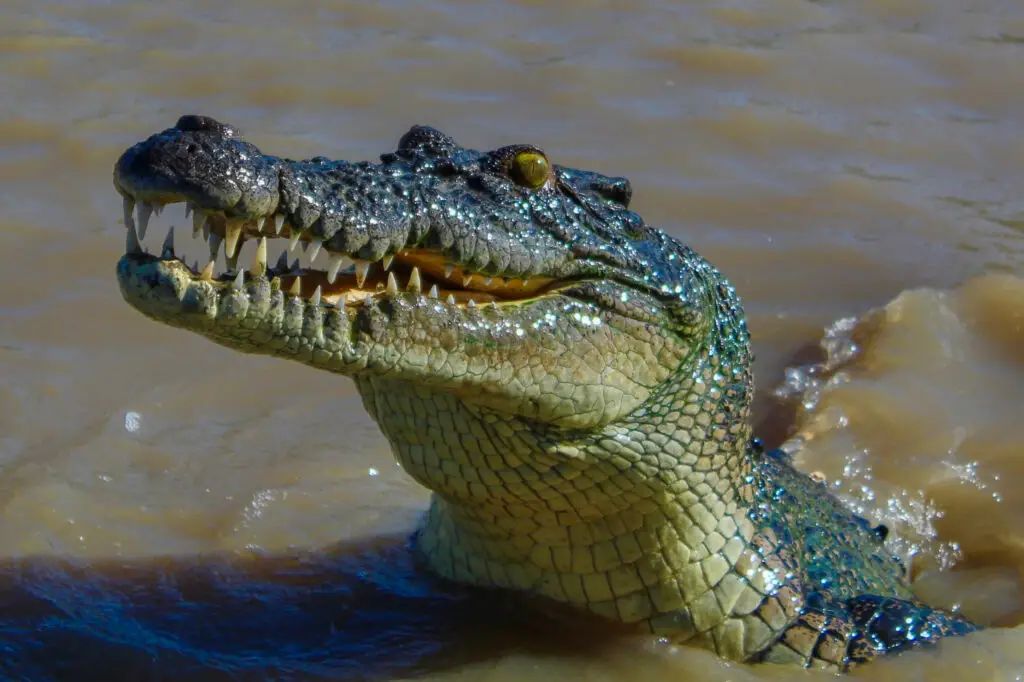
The saltwater crocodile is the largest living reptile and one of the most formidable predators on Earth. These prehistoric-looking creatures can grow up to 23 feet (7 meters) in length and weigh over 2,200 pounds (1,000 kg). Their powerful jaws can exert a bite force of up to 3,700 pounds per square inch, the strongest of any animal alive today. Saltwater crocodiles are opportunistic hunters, capable of taking down almost any animal that enters their territory.
These apex predators have a diverse diet, including fish, birds, and mammals as large as water buffalo. They’re known for their ambush hunting technique, lying silently near the water’s edge before lunging to seize their prey. Saltwater crocodiles can even take on other apex predators like sharks. Despite their fearsome reputation, they face threats from habitat loss and conflict with humans. Conservation efforts have helped their population recover, with an estimated 200,000 to 300,000 individuals left in the wild.
6. Polar Bear
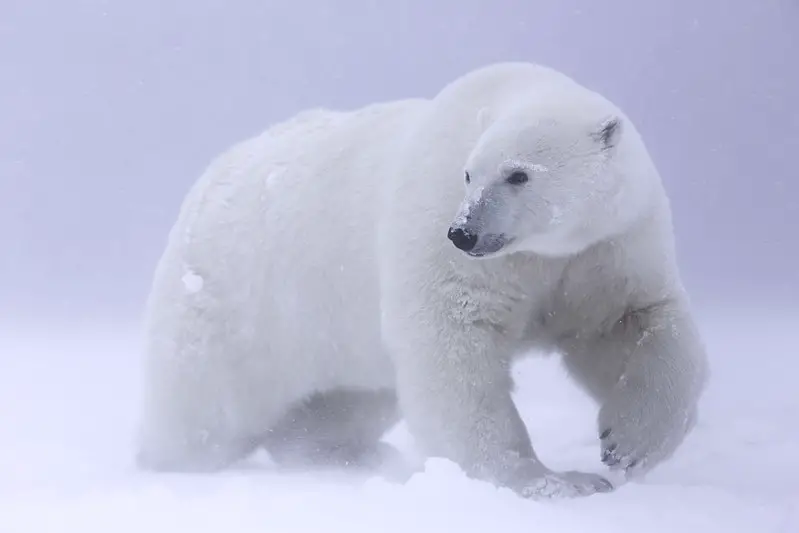
The polar bear, the largest land carnivore, is a master of survival in the harsh Arctic environment. These marine mammals can weigh up to 1,500 pounds (680 kg) and stand 10 feet (3 meters) tall on their hind legs. Their white fur, actually transparent and hollow, provides excellent insulation and camouflage. Polar bears are exceptional swimmers, capable of covering distances of up to 60 miles (96 km) in open water.
As apex predators, polar bears primarily hunt seals, their preferred prey. They have an incredible sense of smell, able to detect a seal from 20 miles (32 km) away. Their hunting strategy involves patiently waiting by breathing holes in the ice. Despite their strength, polar bears face significant threats from climate change. As Arctic sea ice diminishes, their hunting grounds shrink. It’s estimated that there are only 22,000-31,000 polar bears left in the wild, highlighting the urgent need for conservation efforts focused on reducing greenhouse gas emissions and protecting critical habitats.
7. Grizzly Bear
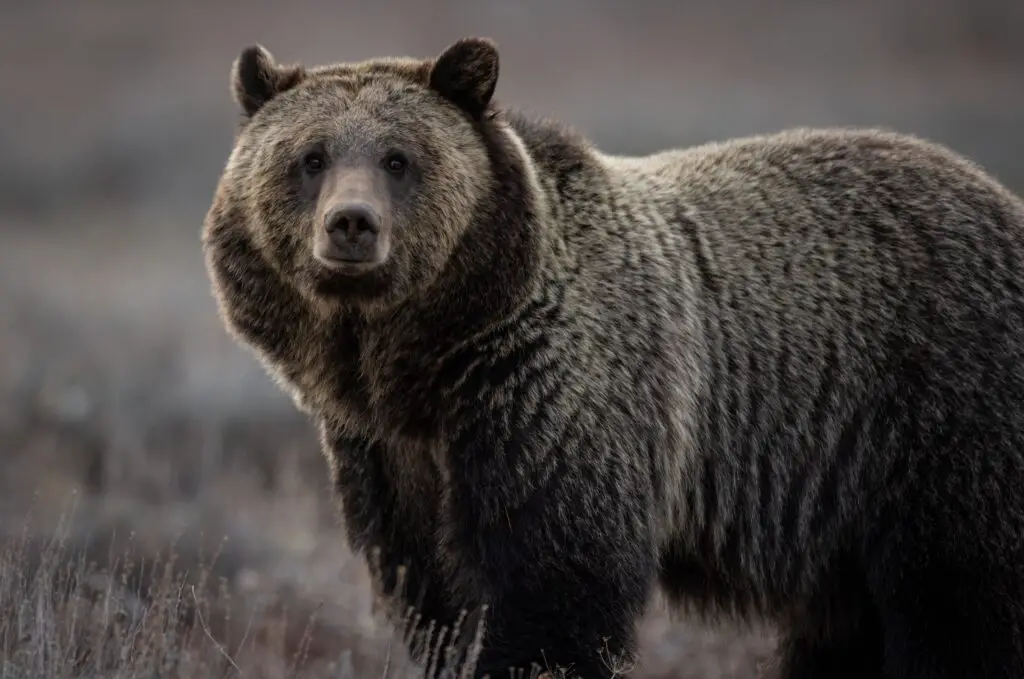
The grizzly bear, a subspecies of brown bear, is an iconic symbol of North American wilderness. These massive omnivores can weigh up to 1,500 pounds (680 kg) and stand up to 8 feet (2.4 meters) tall on their hind legs. Grizzlies have an exceptional sense of smell, seven times more powerful than a bloodhound’s, allowing them to detect food from miles away. Despite their size, they can run at speeds up to 35 mph (56 km/h) over short distances.
Grizzly bears are opportunistic feeders with a diverse diet. They prey on large mammals like moose, elk, and bison, but also consume fish, berries, and roots. In some areas, grizzlies are significant predators of elk and moose calves, potentially killing up to 51 percent of calves born in a year. Their powerful build and sharp claws make them formidable hunters. Today, there are approximately 55,000 wild grizzly bears in North America, with conservation efforts focusing on habitat protection and reducing human-bear conflicts.
8. Jaguar
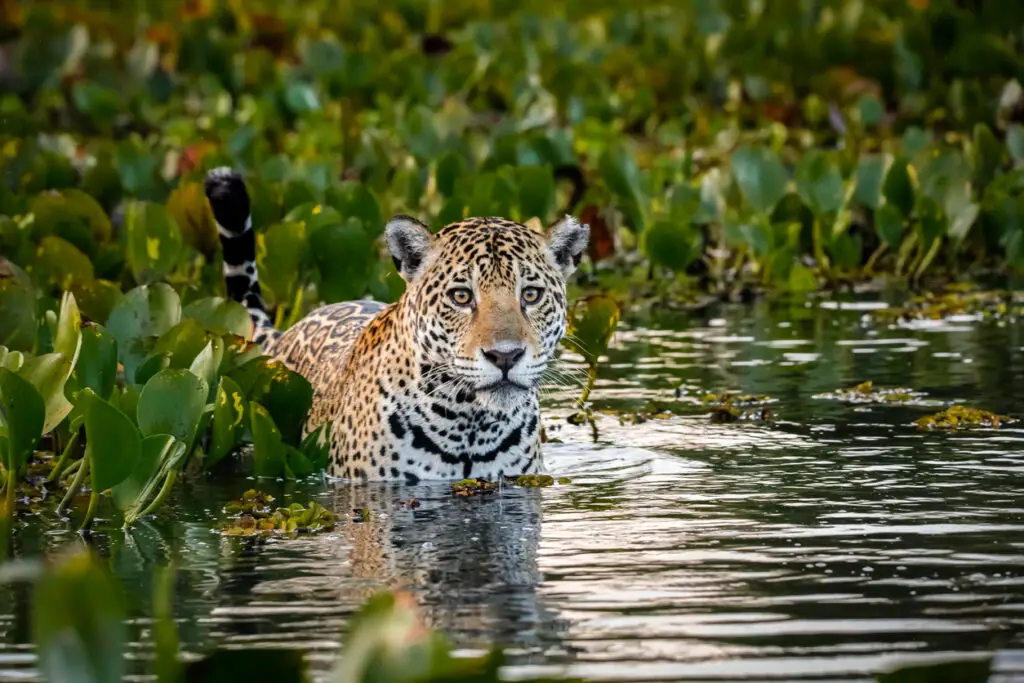
The jaguar, the largest cat in the Americas, is a powerful and stealthy predator. These magnificent felines can weigh up to 350 pounds (158 kg) and measure up to 6 feet (1.8 meters) in length, not including their tail. Jaguars are excellent swimmers and climbers, with a diverse diet that includes over 85 species. Their distinctive coat, covered in rosettes, provides excellent camouflage in dappled forest light.
Known for their exceptionally powerful bite, jaguars have the strongest jaws of any big cat relative to their size. They can bite through turtle shells and pierce the skulls of their prey. Jaguars are opportunistic hunters, employing a stalk-and-ambush strategy. Their prey ranges from capybaras and deer to caimans and even small sharks. Sadly, jaguars are near threatened, with an estimated 64,000 individuals left in the wild. Habitat loss and fragmentation pose the greatest threats to their survival, highlighting the need for conservation efforts focused on protecting and connecting their habitats.
9. Komodo Dragon

The Komodo dragon, the world’s largest lizard, is a formidable predator native to several Indonesian islands. These ancient reptiles can grow up to 10 feet (3 meters) long and weigh up to 366 pounds (166 kg). Their long, forked tongues can detect carrion from 5.9 miles (9.5 km) away, making them efficient hunters and scavengers.
Komodo dragons possess a venomous bite, a discovery made only in 2009. Their saliva contains over 50 strains of bacteria and venom glands, causing rapid blood loss and inhibiting clotting in their prey. These lizards can eat up to 80% of their body weight in a single meal. Despite their fearsome reputation, Komodo dragons are vulnerable to extinction. Only about 4,000-5,000 individuals remain in the wild, their habitat restricted to a few islands. Conservation efforts focus on protecting their island habitats and monitoring wild populations to ensure their survival.
10. Harpy Eagle
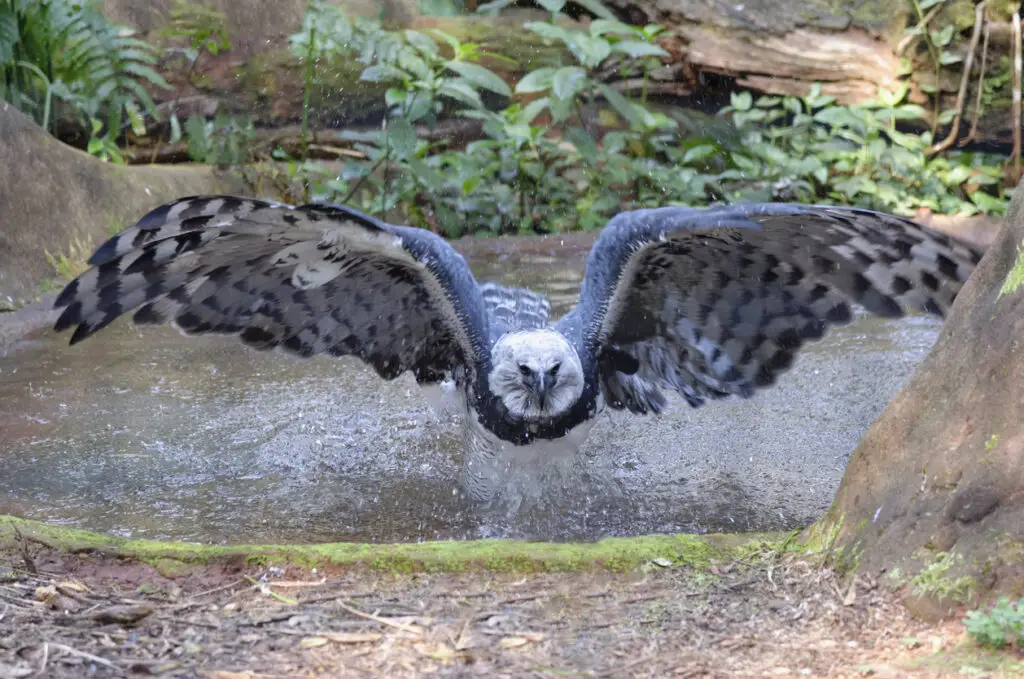
The harpy eagle is one of the most powerful birds of prey, ruling the rainforest canopies of Central and South America. With a wingspan reaching 6.5 feet (2 meters) and weighing up to 20 pounds (9 kg), it’s among the largest eagles in the world. Their legs can be as thick as a small child’s wrist, with talons measuring 3-4 inches (7.6-10.2 cm) long.
Harpy eagles have excellent vision, able to spot prey from over 650 feet (200 meters) away. They primarily hunt tree-dwelling mammals like sloths and monkeys, capable of carrying prey equal to their body weight. These birds are known for their distinctive double crest, which they can raise to create a disc shape, enhancing their hearing. Due to habitat loss from deforestation, harpy eagles are considered near threatened. There are estimated to be less than 50,000 individuals left in the wild, emphasizing the need for conservation efforts to protect large tracts of undisturbed rainforest crucial for their survival.
11. African Wild Dog
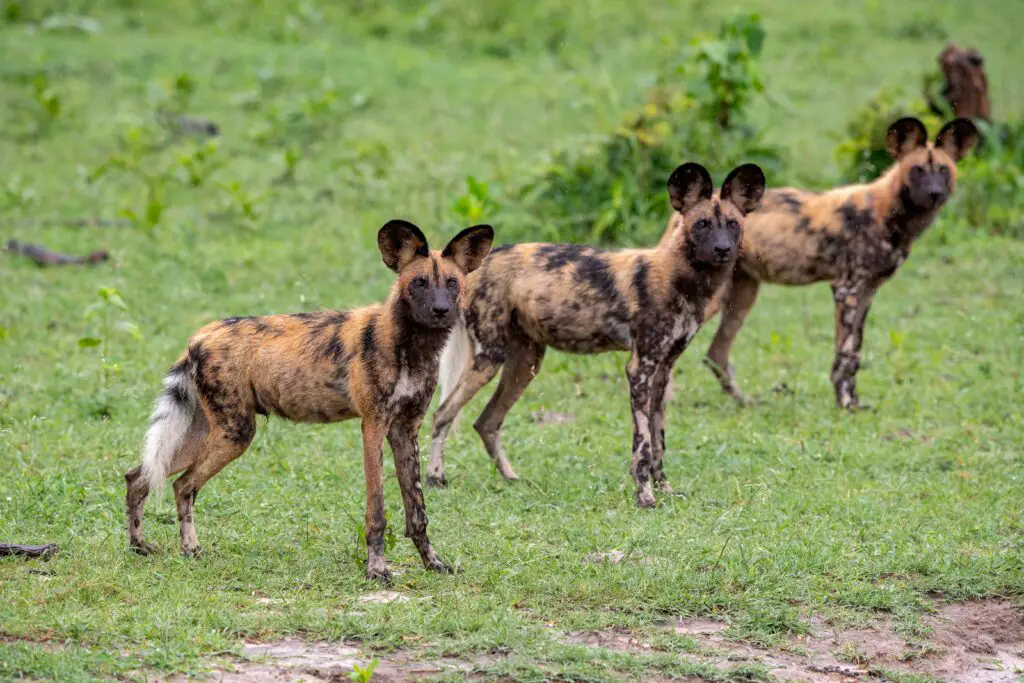
The African wild dog, also known as the painted wolf, is a highly social and efficient predator native to sub-Saharan Africa. These unique canids sport distinctive mottled coat patterns and large rounded ears. Weighing between 40-80 pounds (18-36 kg), they’re smaller than wolves but larger than most other wild canid species. African wild dogs live in packs of up to 40 individuals, led by an alpha pair.
These apex predators are among the most successful hunters in Africa, with a hunt success rate of up to 80%. They use stamina and teamwork to chase down prey over long distances, sometimes running for miles at speeds up to 44 mph (70 km/h). Despite their hunting prowess, African wild dogs are endangered, with only about 6,600 individuals left in the wild. Habitat fragmentation, human-wildlife conflict, and diseases spread by domestic dogs are their primary threats.
12. Nile Crocodile
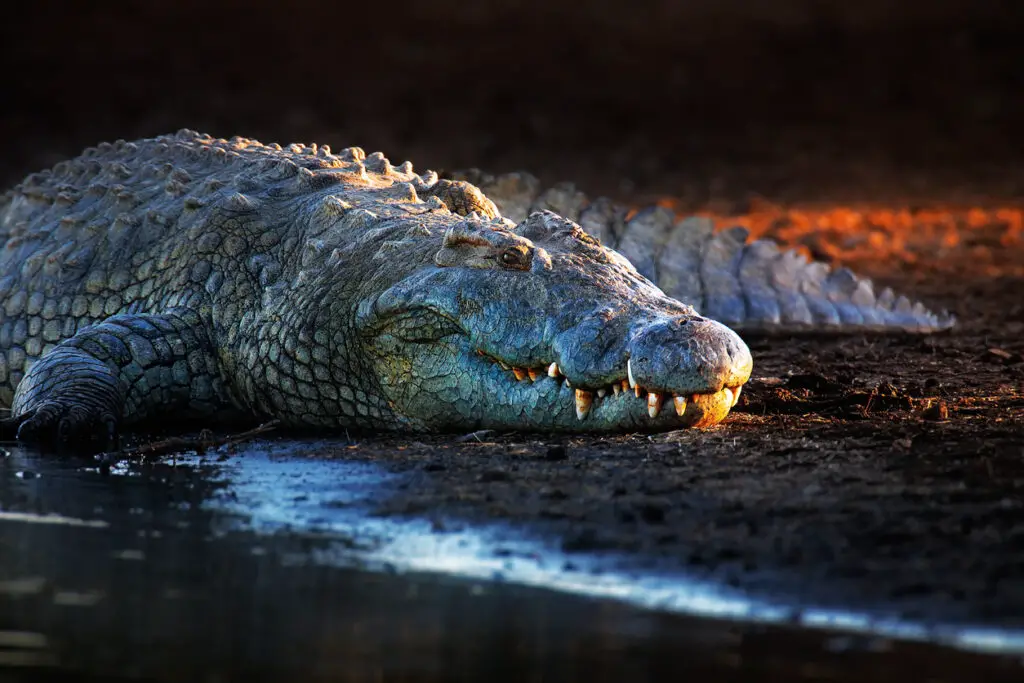
The Nile crocodile is one of Africa’s most formidable apex predators, found in various aquatic habitats across sub-Saharan Africa. These ancient reptiles can grow up to 20 feet (6 meters) in length and weigh up to 1,650 pounds (750 kg). Their powerful jaws can exert a bite force of up to 5,000 pounds per square inch (psi), making them capable of taking down large prey such as wildebeest and even young hippos.
Nile crocodiles are opportunistic hunters, lying in wait at the water’s edge before lunging at unsuspecting prey. They play a crucial role in their ecosystems, helping to maintain the balance of fish populations and recycling nutrients. These crocodiles can potentially live up to 100 years in the wild. Despite their fearsome reputation, they face threats from habitat loss, pollution, and human conflict. The current population of Nile crocodiles is estimated to be between 250,000 to 500,000 individuals.
13. Golden Eagle
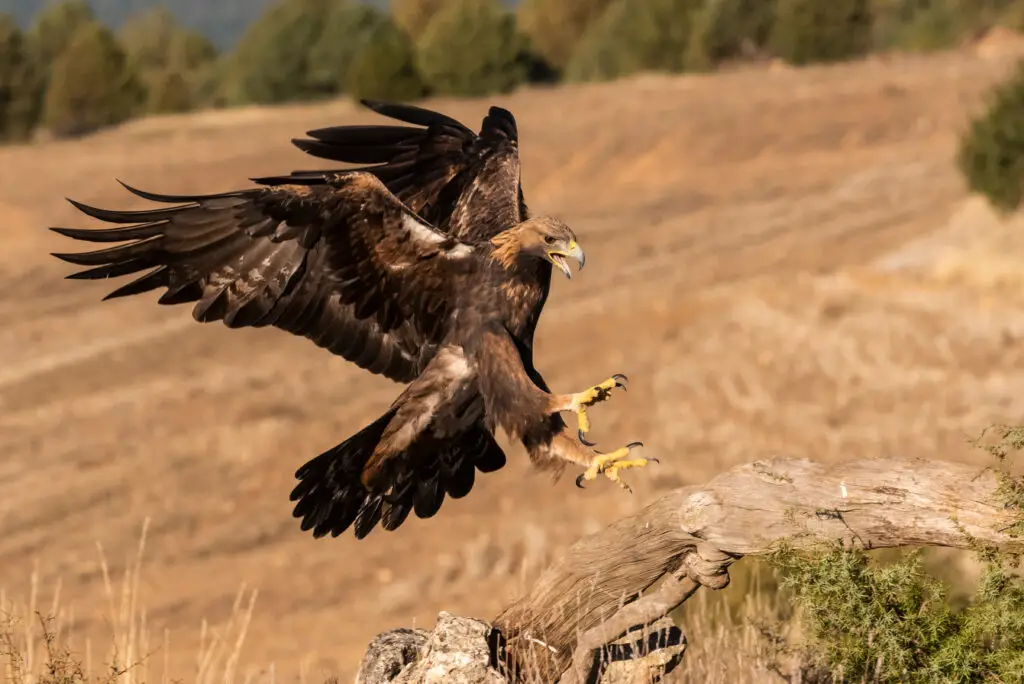
The golden eagle is one of the most impressive and widespread birds of prey, found across North America, Europe, and Asia. With a wingspan of up to 7.5 feet (2.3 meters) and weighing up to 15 pounds (6.8 kg), these raptors are formidable hunters. Their keen eyesight is about eight times sharper than that of humans, allowing them to spot prey from great distances.
Golden eagles are known for their agility and speed, capable of diving at speeds over 150 mph (240 km/h) when hunting. They primarily prey on small to medium-sized mammals like rabbits and hares, but they’re also known to take down larger animals such as deer and even other birds of prey. In some regions, they’ve been observed hunting in pairs to take down larger prey. While not globally threatened, golden eagles face challenges from habitat loss, collisions with wind turbines, and illegal hunting. Conservation efforts focus on protecting their nesting sites and migratory routes.
14. Wolf
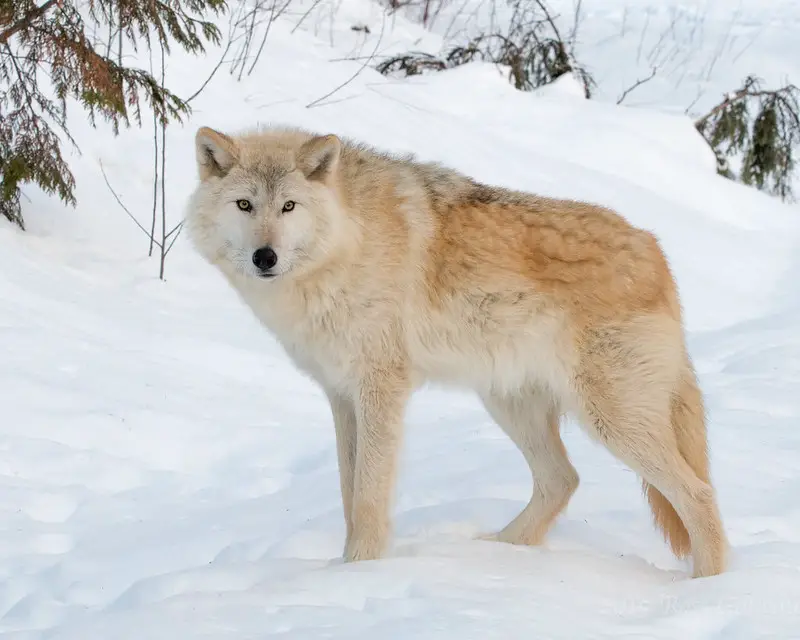
The wolf is an iconic apex predator found across North America, Europe, and Asia. These highly social canines typically weigh between 60-145 pounds (27-66 kg) and can reach lengths of up to 6.5 feet (2 meters) including their tail. Wolves are known for their intelligence, complex social structures, and remarkable endurance.
Wolves hunt in packs, taking down prey much larger than themselves, such as elk, moose, and bison. Their hunting strategy relies on teamwork and communication, using a variety of vocalizations including their famous howl. Despite their fearsome reputation, wolf populations have been severely impacted by human activities. Conservation efforts have helped some populations recover, but many still face threats from habitat loss and conflict with humans.
15. Leopard
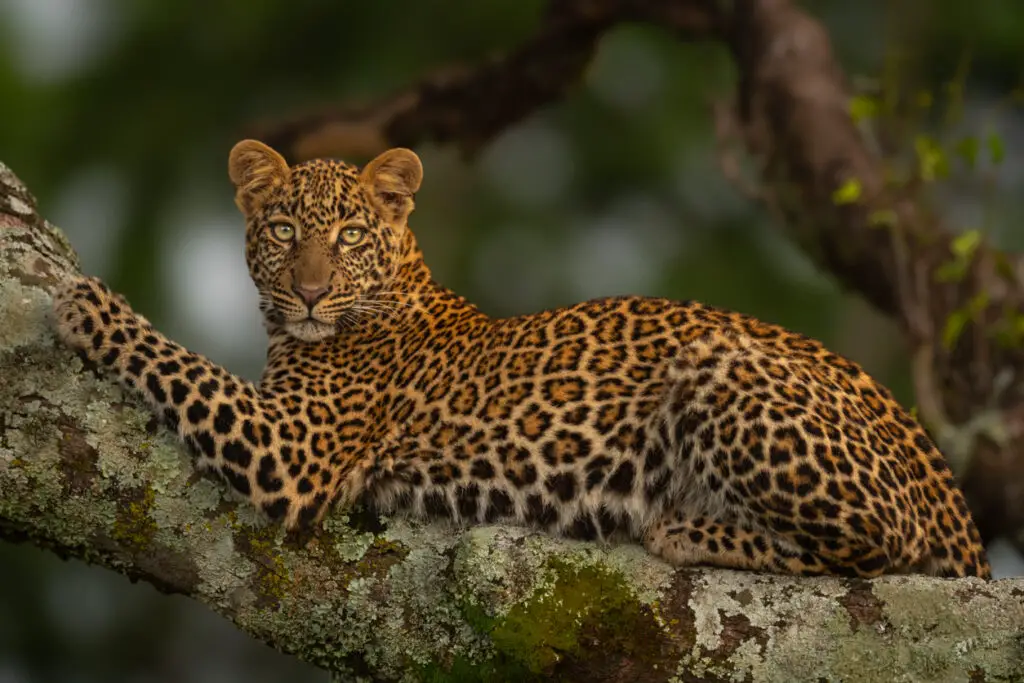
The leopard is a versatile and adaptable big cat found across Africa and parts of Asia. Known for their spotted coats and exceptional strength, leopards can weigh up to 200 pounds (90 kg) and measure up to 6.5 feet (2 meters) in length. They are incredibly agile, capable of climbing trees while carrying prey twice their own weight.
Leopards are solitary hunters, relying on stealth and ambush tactics. Their diverse diet includes over 90 species, from small rodents to large antelopes. Unlike many big cats, leopards are comfortable in a wide range of habitats, from dense forests to urban areas. However, habitat loss and human conflict have led to declining populations in many areas. Conservation efforts focus on protecting their habitats and reducing human-leopard conflicts.
16. Cheetah
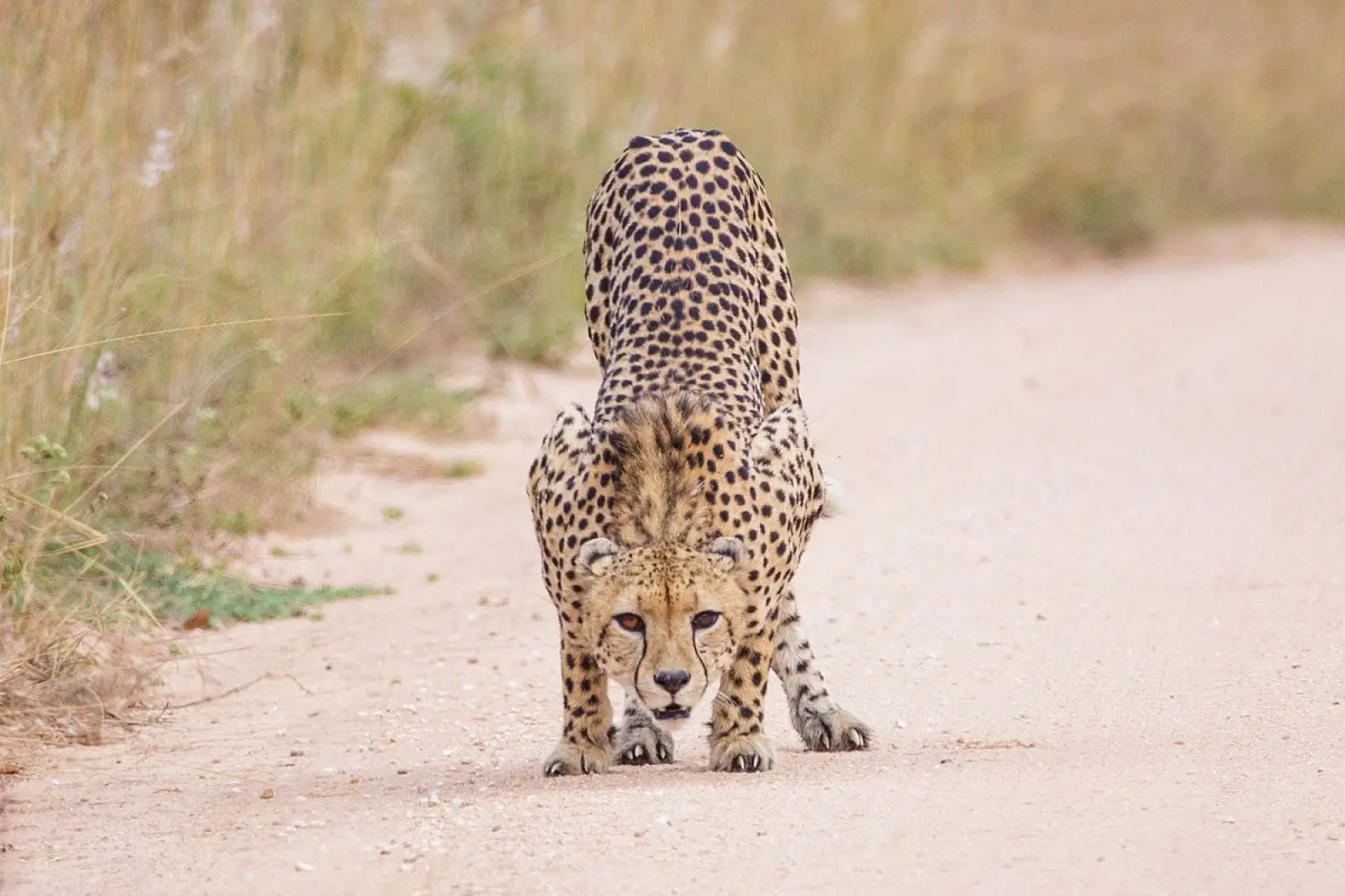
The cheetah is the fastest land animal, capable of reaching speeds up to 70 mph (112 km/h) in short bursts. These sleek cats weigh between 75-140 pounds (34-64 kg) and can measure up to 4.5 feet (1.4 meters) in length, not including their tail. Their unique body structure, including a flexible spine and semi-retractable claws, makes them built for speed.
Cheetahs are diurnal hunters, relying on their incredible speed to chase down prey like gazelles and impalas. Unlike other big cats, cheetahs kill their prey through suffocation rather than a bite to the neck or skull. Despite their impressive hunting abilities, cheetahs face numerous threats. With only about 7,100 adults left in the wild, they’re considered vulnerable to extinction. Habitat loss, human conflict, and a lack of genetic diversity are their primary challenges.
17. Cougar
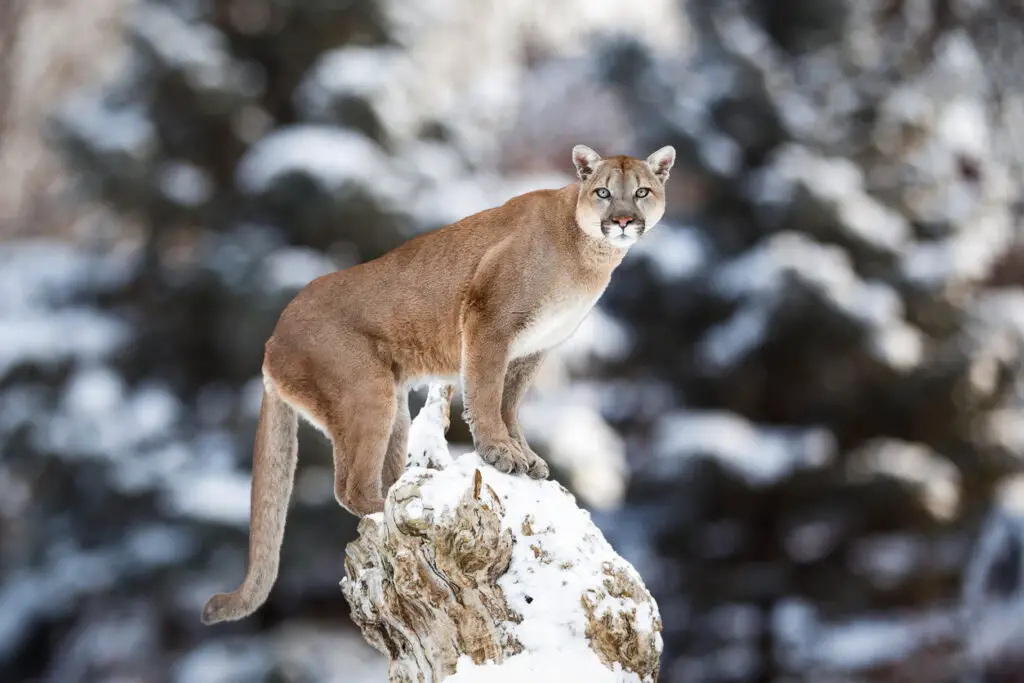
The cougar, also known as the mountain lion or puma, is a stealthy predator native to the Americas. These muscular cats can weigh up to 200 pounds (90 kg) and stretch over 8 feet (2.4 meters) from nose to tail tip. Their powerful hind legs enable them to leap an astonishing 40 feet (12 meters) horizontally and 15 feet (4.5 meters) vertically.
Masters of ambush, cougars prefer to stalk their prey before pouncing with deadly precision. They’re opportunistic hunters, taking down everything from deer to small rodents. Despite their impressive size, cougars are known for their elusive nature, rarely seen by humans. Habitat fragmentation and conflicts with livestock have led to population declines in many areas, prompting conservation efforts to protect these magnificent felines and their ecosystems.
18. Snow Leopard
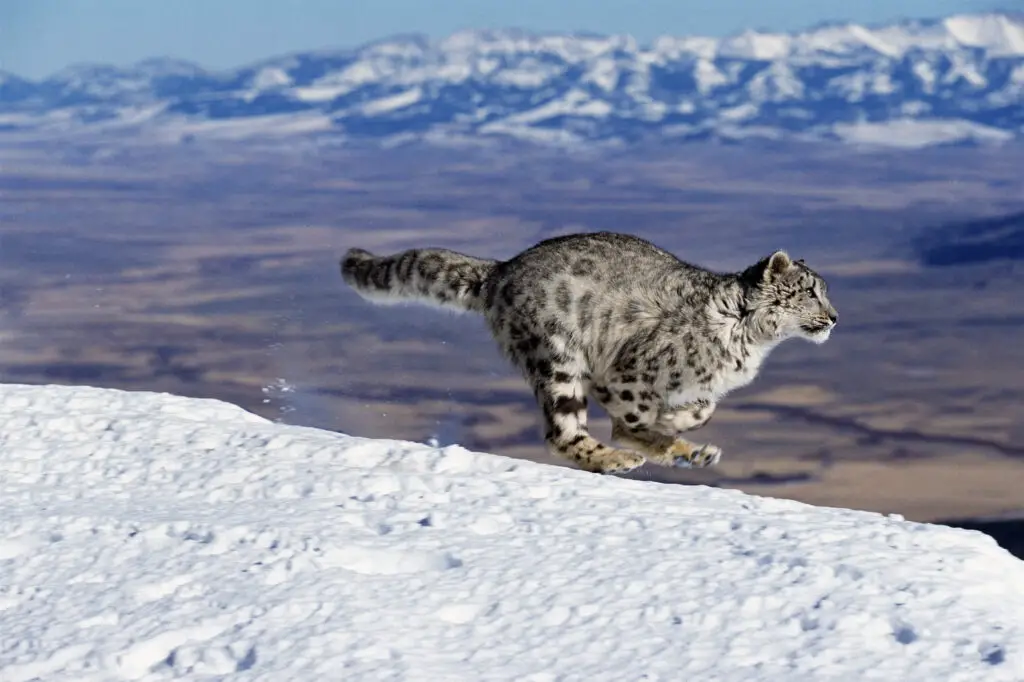
The snow leopard, often called the “ghost of the mountains,” is a master of camouflage in the rugged terrain of Central Asia. Weighing up to 120 pounds (54 kg), these cats sport thick, pale gray fur with dark rosettes, perfectly blending into their snowy habitat. Their oversized paws act like natural snowshoes, while their long, thick tails provide balance on steep slopes and serve as cozy scarves in harsh weather.
These elusive predators are incredibly agile, capable of leaping six times their body length to catch prey. Snow leopards primarily hunt wild sheep and goats, but they’re not picky eaters, sometimes taking on animals three times their size. With an estimated population of 4,000-6,500 in the wild, snow leopards face threats from poaching and habitat loss. Conservation efforts focus on protecting their mountain habitats and reducing human-wildlife conflicts.
19. Bald Eagle
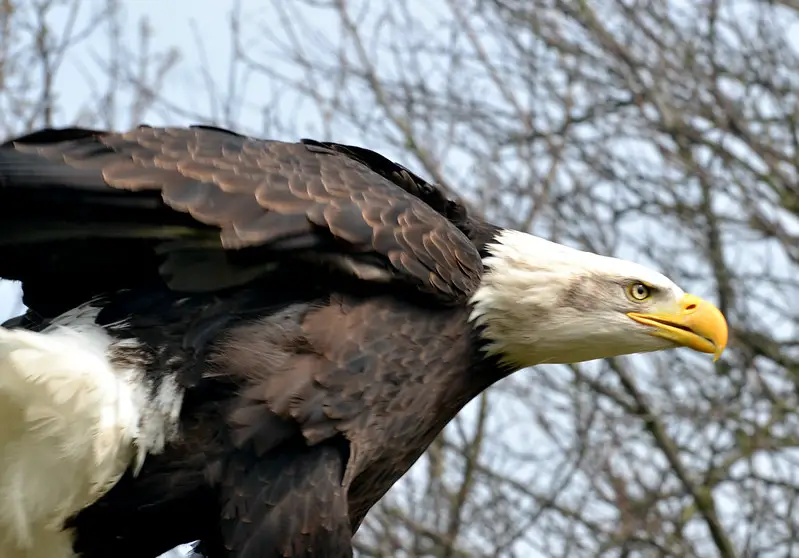
The bald eagle, America’s national bird, is a striking raptor with a wingspan reaching up to 7.5 feet (2.3 meters). Despite their name, these majestic birds aren’t bald – their white head feathers contrast sharply with their dark brown body and wings. Bald eagles can weigh up to 14 pounds (6.3 kg), with females typically larger than males.
Expert fishers, bald eagles swoop down to snatch fish from the water’s surface with their razor-sharp talons. They’re also opportunistic feeders, stealing prey from other birds and scavenging when necessary. Once endangered due to DDT poisoning, bald eagles have made a remarkable comeback thanks to conservation efforts. Today, they face challenges from habitat loss and lead poisoning from ingesting prey shot with lead ammunition. Protecting their nesting sites and maintaining clean waterways are key to their continued recovery.
20. King Cobra
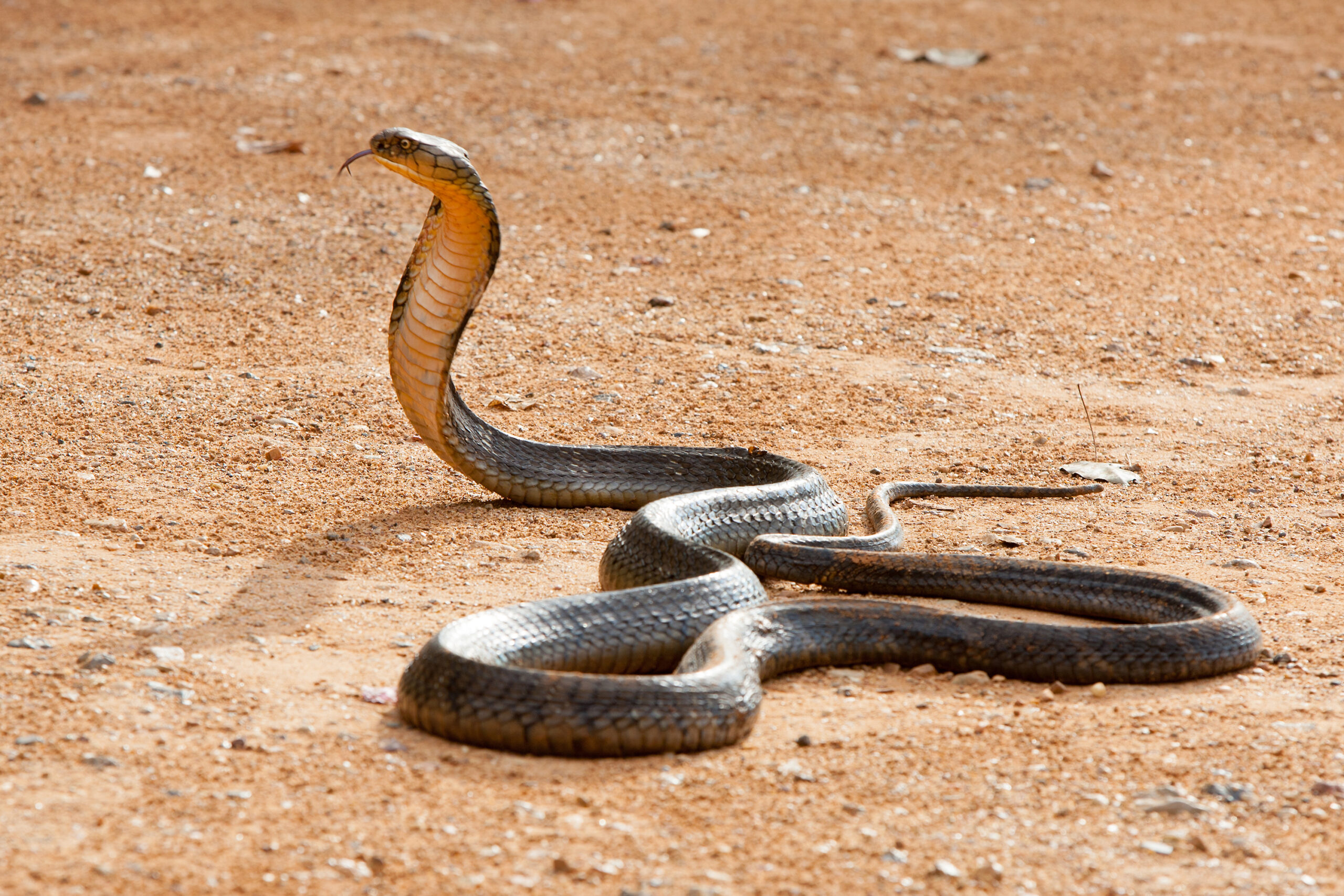
The king cobra reigns supreme as the world’s longest venomous snake, stretching up to 18 feet (5.5 meters) in length. Native to South and Southeast Asia, these impressive serpents can rear up to a third of their body length, delivering a menacing hood display. Their venom is potent enough to kill an elephant, making them one of the most feared predators in their habitat.
Unlike other snakes, king cobras are known for their intelligence and ability to plan attacks. They primarily feed on other snakes, earning their genus name Ophiophagus, meaning “snake-eater.” Despite their deadly reputation, king cobras face threats from habitat loss and human persecution. Conservation efforts focus on protecting their forest habitats and educating local communities about their ecological importance.
21. Peregrine Falcon
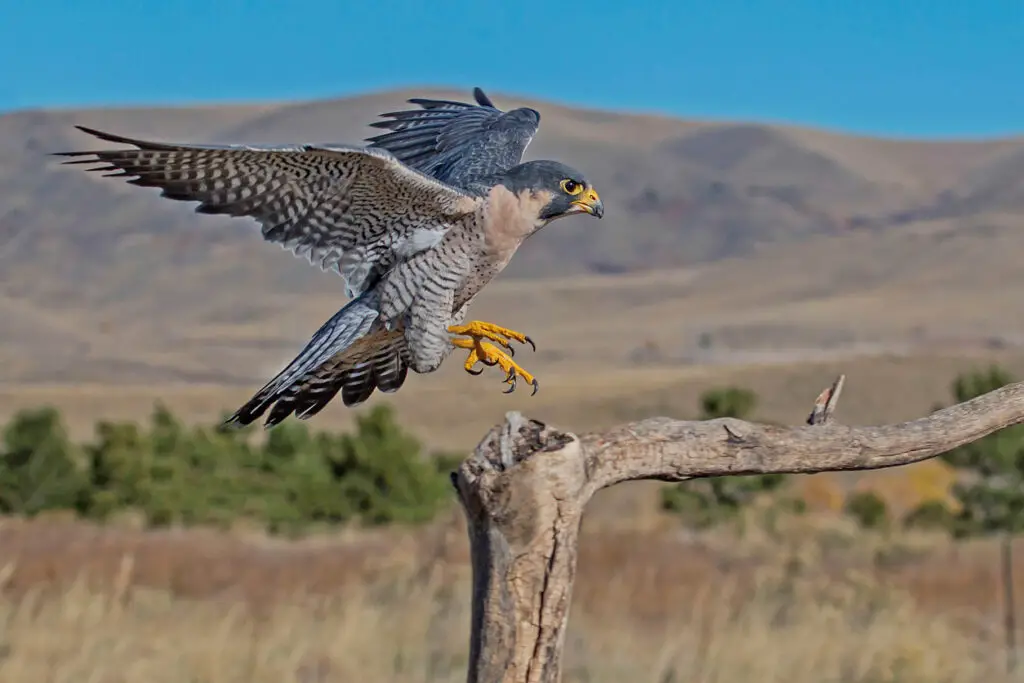
The peregrine falcon is nature’s speed demon, capable of reaching speeds over 240 mph (386 km/h) during its hunting stoop, making it the fastest animal on Earth. These raptors have a compact body, pointed wings, and a distinctive “mustache” marking on their face. With a wingspan up to 3.6 feet (1.1 meters), they’re built for high-speed aerial pursuits.
Peregrines are master hunters, specializing in taking down other birds in mid-flight. Their incredible speed and agility allow them to catch prey as varied as pigeons, ducks, and even other raptors. Once endangered due to DDT use, peregrine falcons have made a remarkable recovery thanks to conservation efforts. Today, they’ve adapted to urban environments, nesting on skyscrapers and hunting pigeons in city centers, showcasing their remarkable adaptability.
22. Spotted Hyena
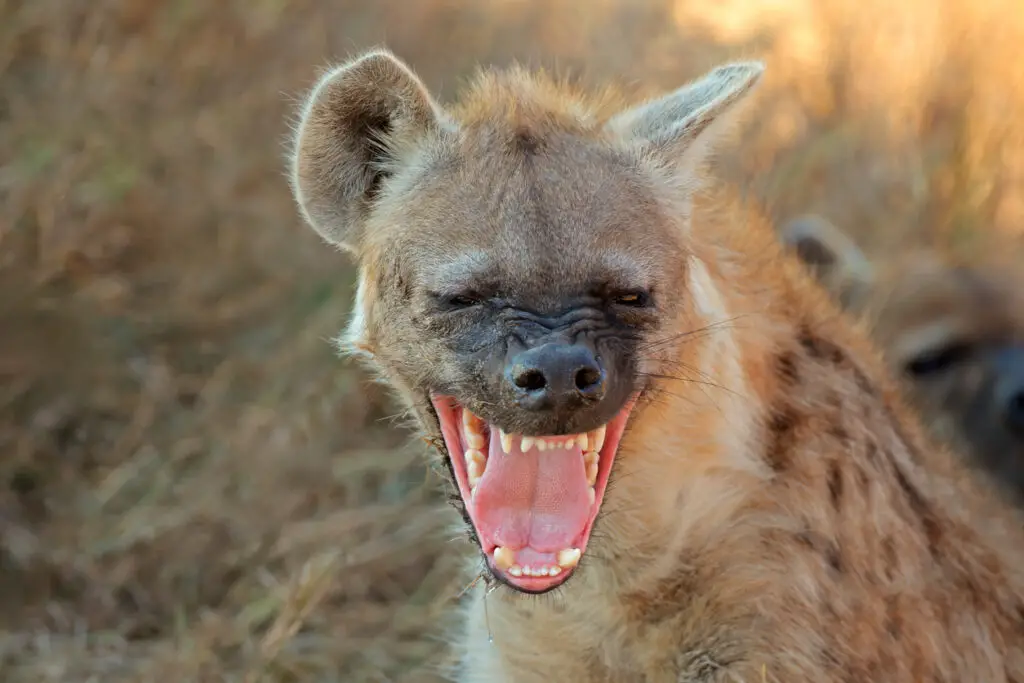
Often misunderstood, the spotted hyena is a formidable predator and not just a scavenger. These social carnivores can weigh up to 190 pounds (86 kg) and are known for their distinctive “laughing” vocalizations. Spotted hyenas live in complex social groups called clans, led by dominant females.
With jaws powerful enough to crush bones, spotted hyenas are efficient hunters, often taking down prey larger than themselves. They’re also incredibly intelligent, showing problem-solving skills on par with great apes. Despite their capabilities, hyenas face threats from habitat loss and human conflict. Conservation efforts focus on protecting their habitats and changing public perception of these fascinating and important apex predators.
23. American Alligator
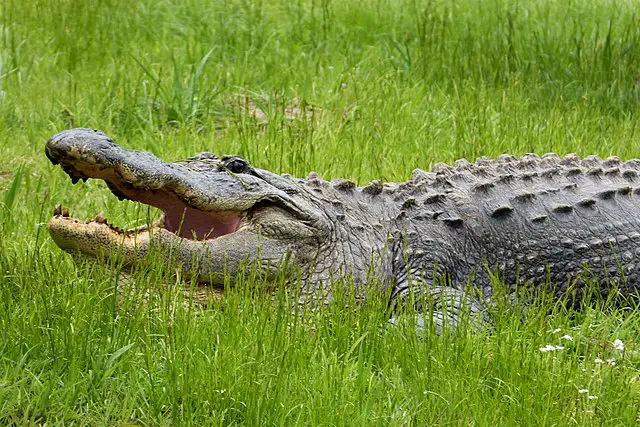
The American alligator is a living fossil, having roamed the Earth for over 150 million years. These impressive reptiles can grow up to 14 feet (4.3 meters) long and weigh up to 1,000 pounds (454 kg). With their armored bodies and powerful tails, they’re perfectly adapted to life in the swamps and wetlands of the southeastern United States.
Alligators are ambush predators, using their incredible patience to wait for the perfect moment to strike. Their diet includes fish, turtles, birds, and even deer that venture too close to the water’s edge. Once hunted to near extinction, American alligators have made a remarkable comeback thanks to conservation efforts. Today, they face challenges from habitat loss and climate change, highlighting the need for continued protection of wetland ecosystems.
24. Anaconda
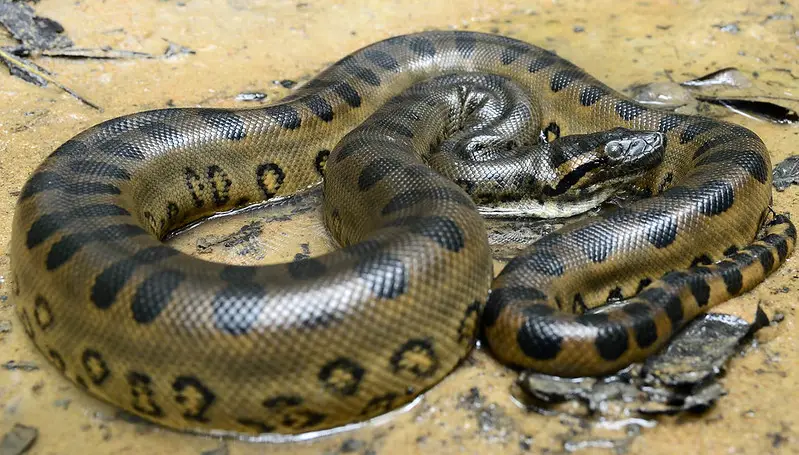
The green anaconda is the heaviest snake in the world, with some individuals reaching lengths of over 29 feet (8.8 meters) and weighing up to 550 pounds (250 kg). Native to the Amazon and Orinoco basins of South America, these massive constrictors are perfectly adapted to life in and around water.
Anacondas are ambush predators, using their excellent camouflage to lie in wait for unsuspecting prey. They can take down animals as large as capybaras and even jaguars, using their powerful bodies to constrict and suffocate their victims before swallowing them whole. Despite their fearsome reputation, anacondas face threats from habitat destruction and hunting. Conservation efforts focus on protecting their rainforest and wetland habitats, crucial for maintaining the delicate balance of these ecosystems.
25. Tasmanian Devil
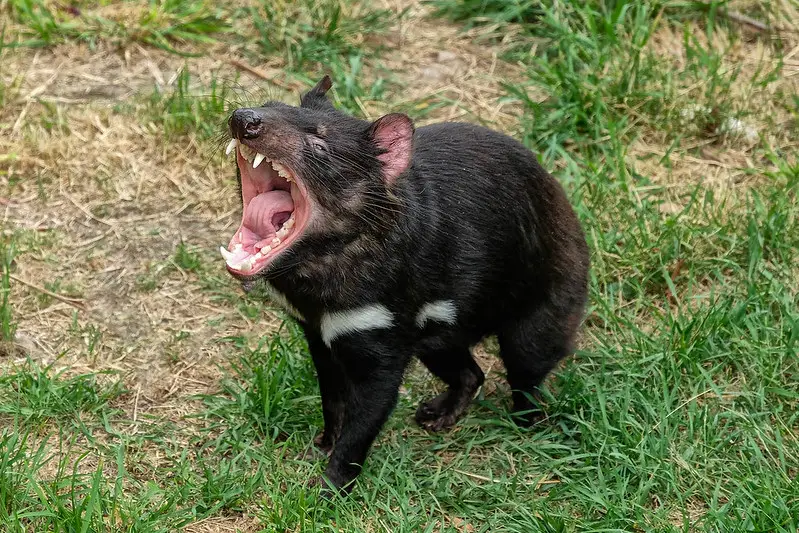
Don’t let their small size fool you – Tasmanian devils are the largest carnivorous marsupials in the world. Native to the island of Tasmania, these feisty creatures weigh up to 26 pounds (12 kg) and are known for their bone-chilling screeches and powerful jaws.
Tasmanian devils are opportunistic feeders, capable of consuming everything from small prey to carrion. Their incredibly strong jaws and teeth allow them to devour entire carcasses, bones and all. Unfortunately, these unique animals face a serious threat from a contagious cancer called Devil Facial Tumor Disease. Conservation efforts are focused on breeding programs and developing a vaccine to save these iconic creatures from extinction.
26. Dhole
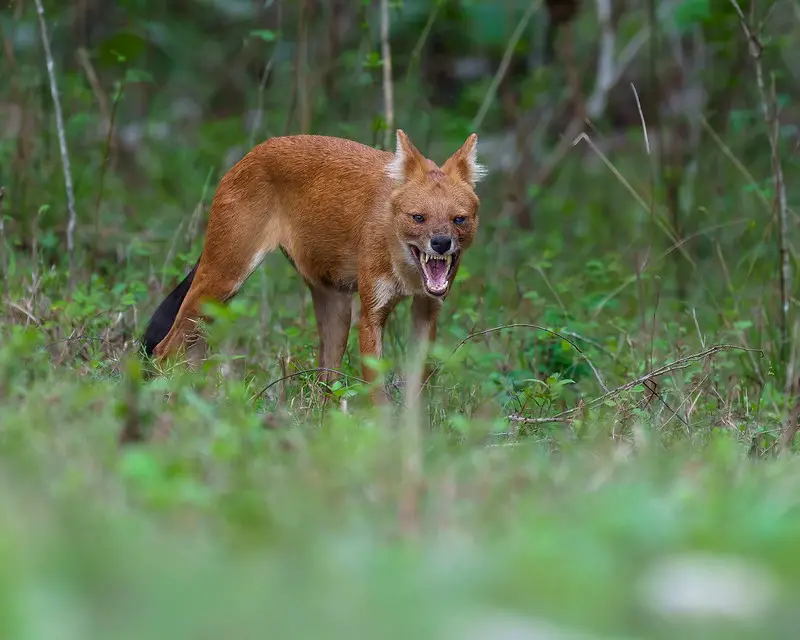
The dhole, also known as the Asiatic wild dog, is a highly social canid native to Central, South, and Southeast Asia. These russet-coated predators weigh up to 50 pounds (23 kg) and are known for their distinctive whistling vocalizations. Dholes live and hunt in packs, using their stamina and teamwork to bring down prey much larger than themselves.
Unlike other canids, dholes have one less molar on each side of their lower jaw, giving them a powerful bite force for their size. They’re capable of taking down animals as large as sambar deer and even tigers in rare instances. Despite their impressive hunting abilities, dholes are endangered, with fewer than 2,500 mature individuals left in the wild. Habitat loss and competition with larger predators pose significant threats to their survival.
27. Wolverine
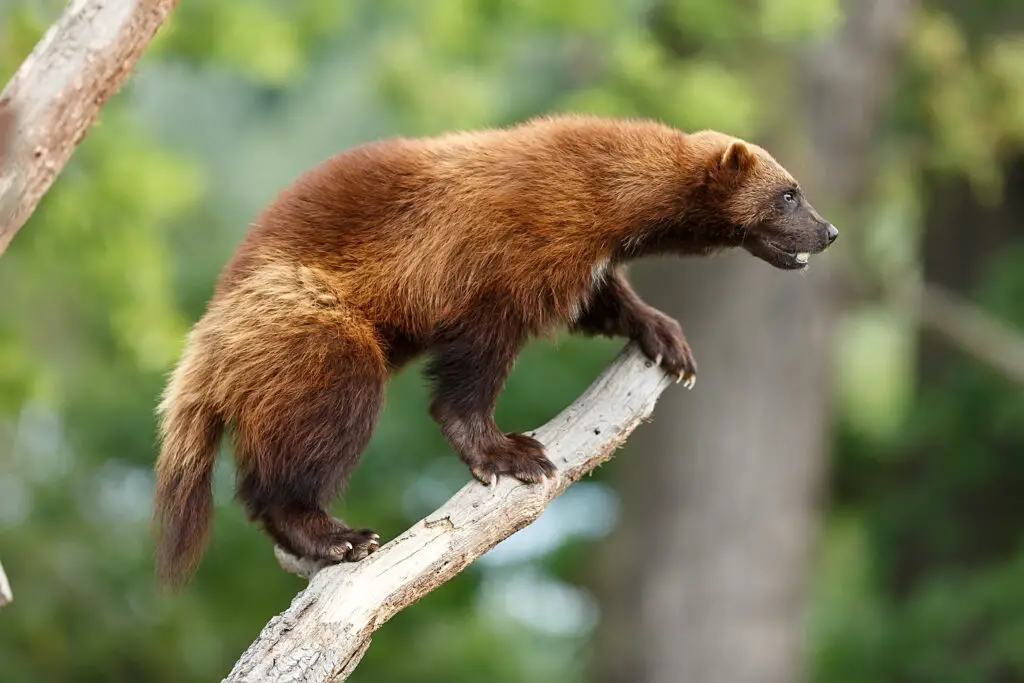
The wolverine, often called “the devil bear,” is a fierce and solitary predator of the northern forests and tundra. Despite weighing only 20-40 pounds (9-18 kg), these muscular members of the weasel family are known for their incredible strength and tenacity. Wolverines have been observed taking down prey as large as caribou and defending their kills against much larger predators like bears.
Equipped with semi-retractable claws and a powerful jaw, wolverines are both skilled hunters and proficient scavengers. Their thick, oily fur is highly resistant to frost, allowing them to thrive in harsh arctic environments. However, climate change poses a significant threat to their snowy habitat. With an estimated global population of less than 25,000, conservation efforts are crucial to ensure the survival of these remarkable creatures.
28. Black Caiman
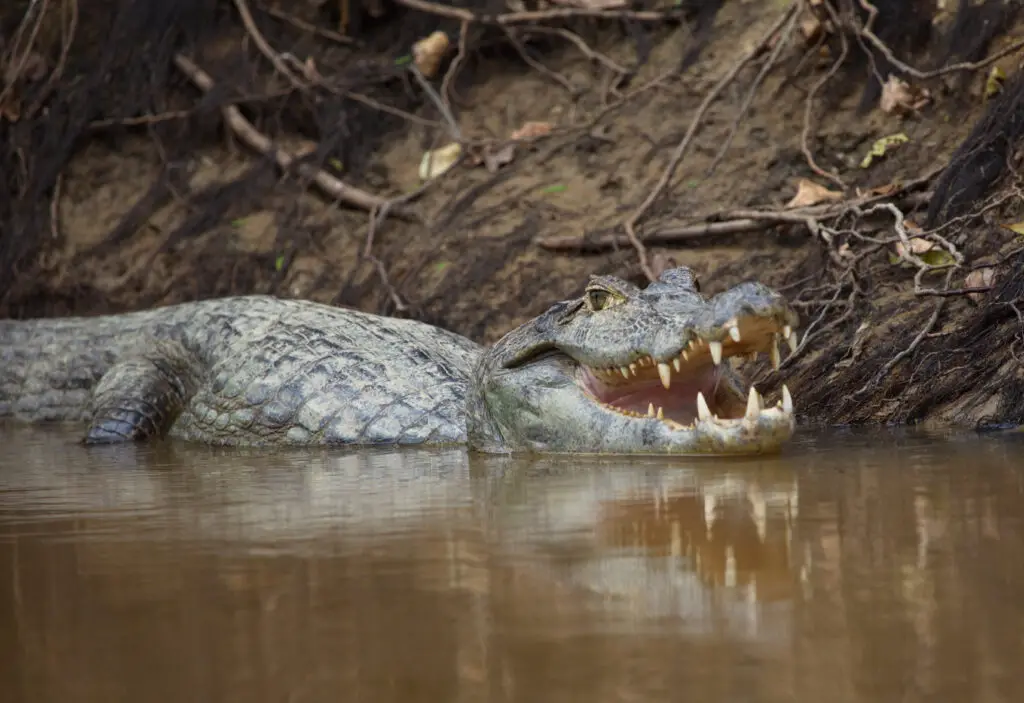
The black caiman is the largest predator in the Amazon ecosystem, with some individuals reaching lengths of up to 20 feet (6 meters). These impressive reptiles are apex predators in their aquatic habitats, capable of taking down large mammals like capybaras and even jaguars that venture too close to the water’s edge.
Black caimans have one of the strongest bite forces of any animal, allowing them to crush the shells of turtles and the bones of their prey. They play a crucial role in maintaining the balance of their ecosystems, controlling populations of fish and other animals. Once heavily hunted for their skin, black caimans have made a comeback in some areas thanks to conservation efforts. However, they still face threats from habitat destruction and conflict with humans.
29. Gharial
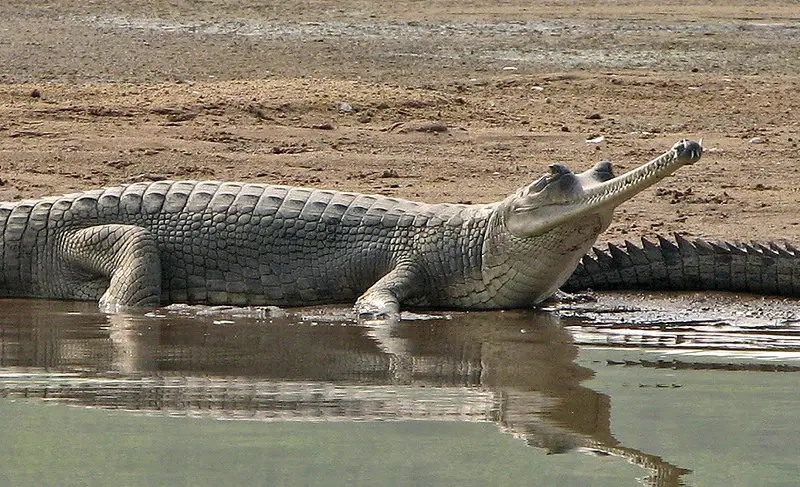
The gharial, with its distinctive long, narrow snout, is one of the most unique-looking crocodilians in the world. Native to the rivers of the Indian subcontinent, these ancient reptiles can grow up to 20 feet (6 meters) in length. Male gharials sport a bulbous growth on the tip of their snout called a ghara, which they use to amplify vocalizations and blow bubbles during mating displays.
Unlike their broader-snouted cousins, gharials are specialized fish-eaters. Their needle-like teeth are perfect for catching and holding slippery prey. Once widespread across South Asia, gharials are now critically endangered, with fewer than 1,000 adults remaining in the wild. Habitat loss, fishing net entanglement, and river pollution pose significant threats to their survival. Conservation efforts focus on breeding programs and protecting their riverine habitats.
30. Giant Otter
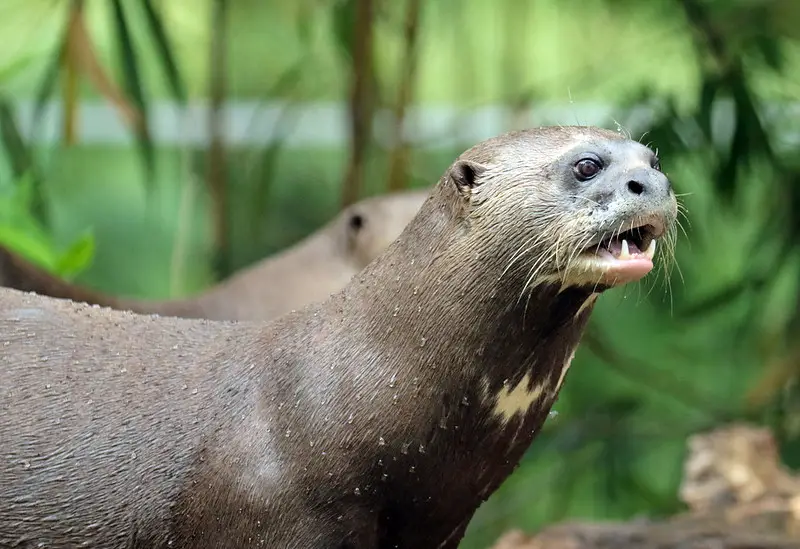
Don’t let their cute appearance fool you – giant otters are the apex predators of South American rivers. Growing up to 6 feet (1.8 meters) long and weighing up to 75 pounds (34 kg), they’re the largest otters in the world. These highly social animals live in family groups and are known for their complex vocalizations, earning them the nickname “river wolves.”
Giant otters are skilled hunters, primarily feeding on fish but also taking down caimans and anacondas when the opportunity arises. Their powerful tails and webbed feet make them excellent swimmers, capable of outmaneuvering most aquatic prey. Unfortunately, giant otters are endangered, with only about 5,000 remaining in the wild. Habitat destruction, pollution, and conflict with humans are their main threats. Conservation efforts focus on protecting their riverine habitats and reducing human-otter conflicts.
31. African Rock Python
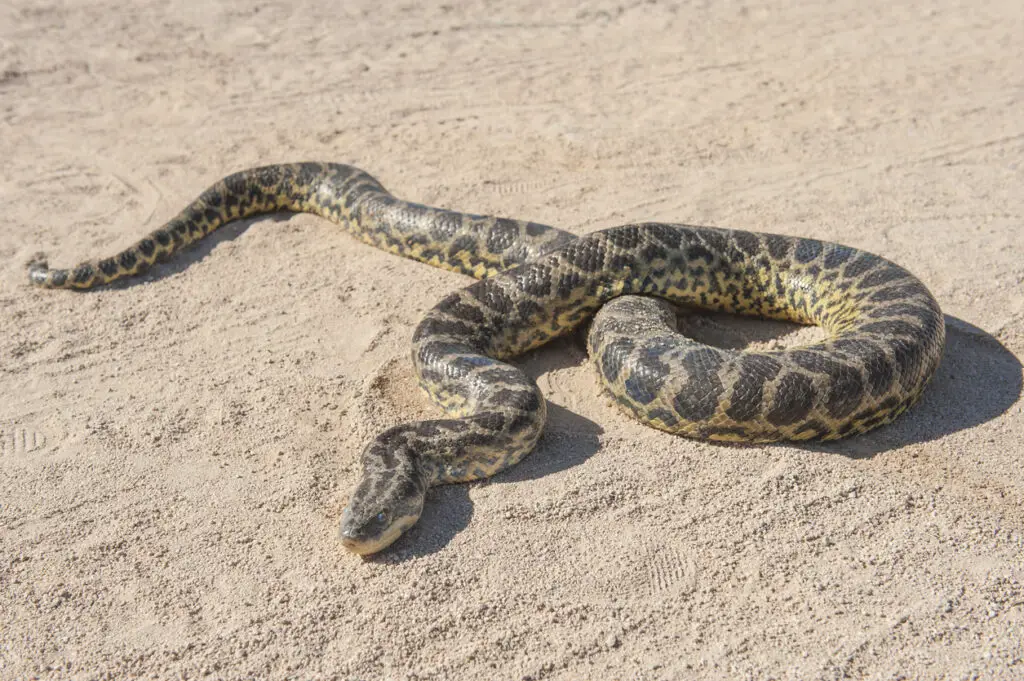
The African rock python is one of the largest snakes in Africa, capable of reaching lengths over 20 feet (6 meters) and weighing up to 200 pounds (90 kg). These non-venomous constrictors are known for their beautiful patterned skin and impressive strength. Found across sub-Saharan Africa, they inhabit a variety of habitats from forests to savannas.
As ambush predators, African rock pythons are capable of taking down prey as large as antelopes and even crocodiles. They use their powerful bodies to constrict their victims before swallowing them whole. Despite their formidable size and strength, these pythons face threats from habitat loss and human persecution. Conservation efforts focus on protecting their diverse habitats and educating local communities about their ecological importance.
32. Reticulated Python
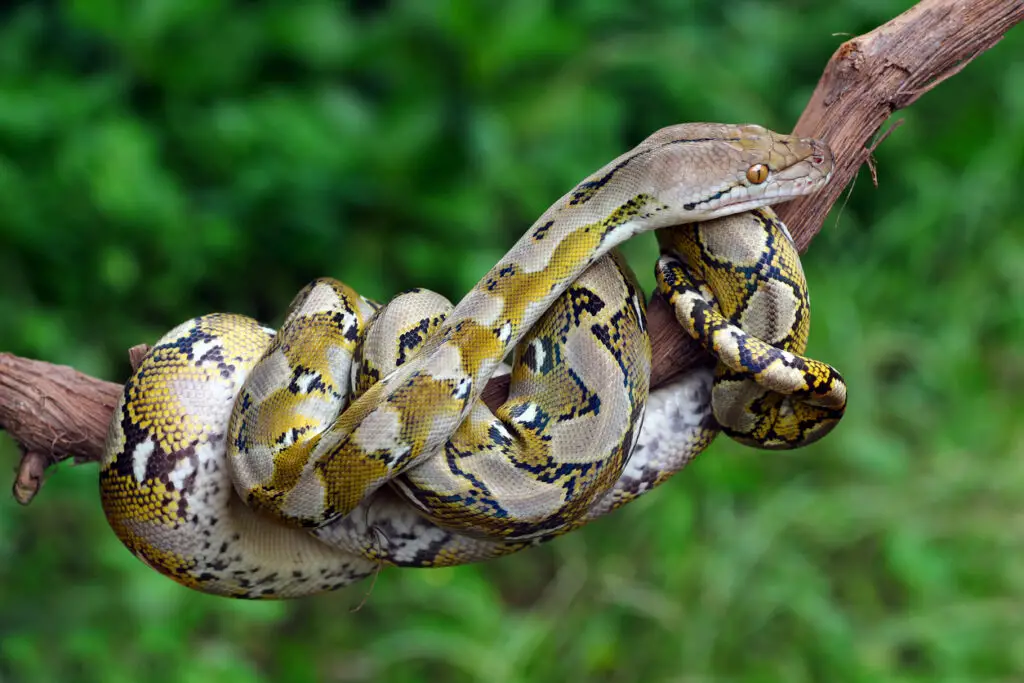
The reticulated python holds the title of the world’s longest snake, with some individuals reaching lengths over 30 feet (9 meters). Native to Southeast Asia, these massive constrictors sport a complex geometric pattern that provides excellent camouflage in their forest habitats. Despite their impressive size, they’re surprisingly agile climbers.
These pythons are ambush predators, capable of taking down prey as large as wild pigs and even small sun bears. Their flexible jaws allow them to swallow prey much larger than their own head. While not endangered, reticulated pythons face threats from habitat loss and the exotic pet trade. Conservation efforts focus on protecting their forest habitats and regulating the international trade in these impressive reptiles.
33. Steller’s Sea Eagle
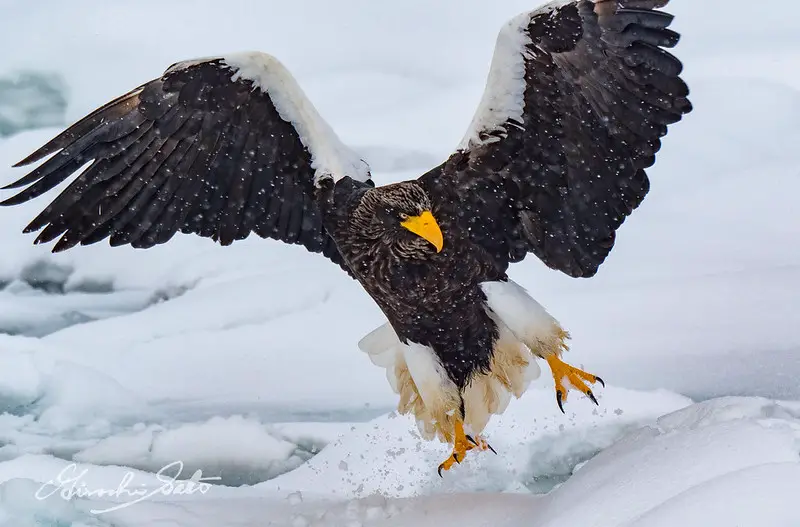
The Steller’s sea eagle is a giant among birds of prey, with a wingspan reaching up to 8 feet (2.4 meters) and weighing up to 20 pounds (9 kg). Native to coastal northeastern Asia, these impressive raptors are easily recognized by their massive yellow beaks and distinctive white shoulders contrasting with dark plumage.
These eagles are specialized fish hunters, capable of snatching salmon from the water’s surface with their powerful talons. They’re also known to prey on seabirds and occasionally small mammals. With a global population of only about 5,000 individuals, Steller’s sea eagles are vulnerable to extinction. Threats include habitat loss, overfishing of their prey species, and pollution. Conservation efforts focus on protecting their breeding grounds and maintaining healthy fish populations in their range.
34. Philippine Eagle

The Philippine eagle, also known as the monkey-eating eagle, is one of the largest and most powerful birds of prey in the world. Endemic to the Philippines, these raptors have a wingspan of up to 7 feet (2.1 meters) and are known for their distinctive shaggy crest. Despite their nickname, their diet consists mainly of flying lemurs and other forest mammals.
These eagles are apex predators in their forest ecosystems, playing a crucial role in controlling populations of their prey species. Unfortunately, they’re critically endangered, with fewer than 400 pairs remaining in the wild. Deforestation is their primary threat, as they require large tracts of undisturbed forest to hunt and breed. Conservation efforts focus on habitat protection, captive breeding programs, and education to reduce human-eagle conflicts.
35. Tiger Shark
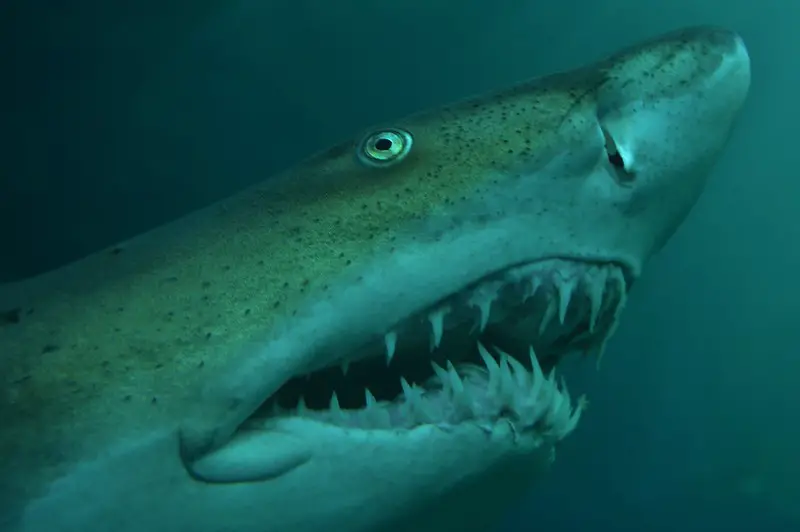
The tiger shark, named for its distinctive dark stripes, is one of the ocean’s most formidable predators. Growing up to 16 feet (5 meters) long and weighing over 1,400 pounds (635 kg), these sharks are known for their powerful jaws and indiscriminate appetite. They’re found in tropical and temperate waters worldwide.
Tiger sharks are often called “garbage cans of the sea” due to their willingness to eat almost anything, from sea turtles and seals to license plates and tires. This adaptability makes them crucial in maintaining marine ecosystem balance. Despite their fearsome reputation, tiger sharks face threats from overfishing and shark finning. Conservation efforts focus on implementing fishing regulations and educating the public about their ecological importance.
36. Bull Shark
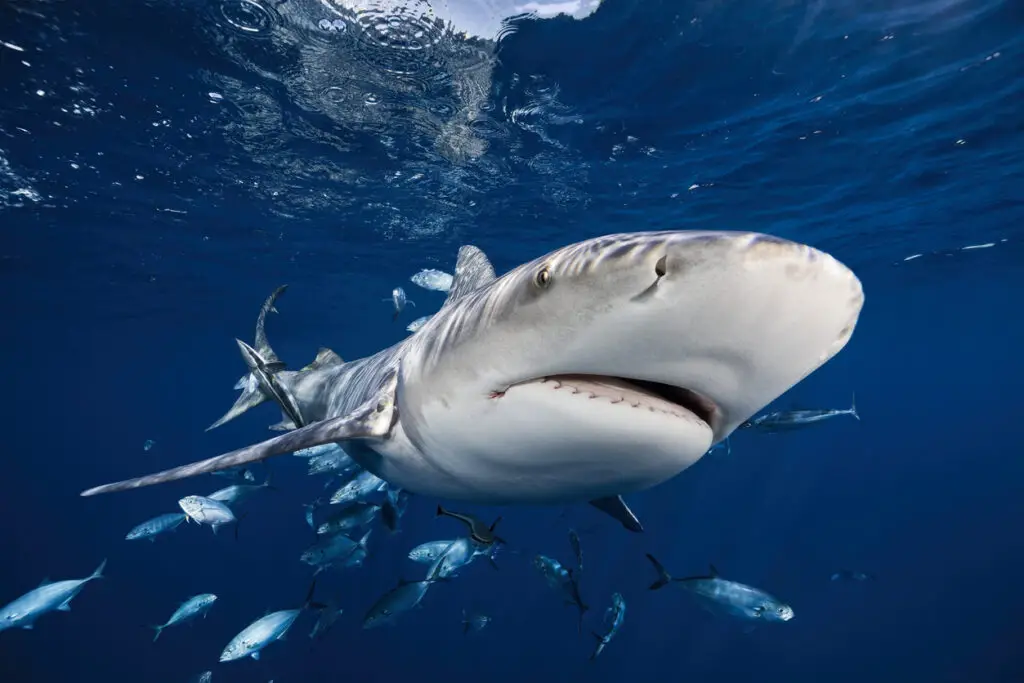
The bull shark is unique among sharks for its ability to tolerate freshwater, venturing far up rivers and even into lakes. These stocky sharks can grow up to 11 feet (3.4 meters) long and are known for their aggressive nature. Their name comes from their short, blunt snout and tendency to head-butt prey before attacking.
Bull sharks are opportunistic feeders, preying on a wide variety of fish, dolphins, and even other sharks. Their ability to enter freshwater environments puts them in frequent contact with humans, leading to their reputation as one of the most dangerous shark species. However, they play a crucial role in both marine and freshwater ecosystems. Conservation efforts focus on protecting their diverse habitats and reducing human-shark conflicts.
37. Mako Shark
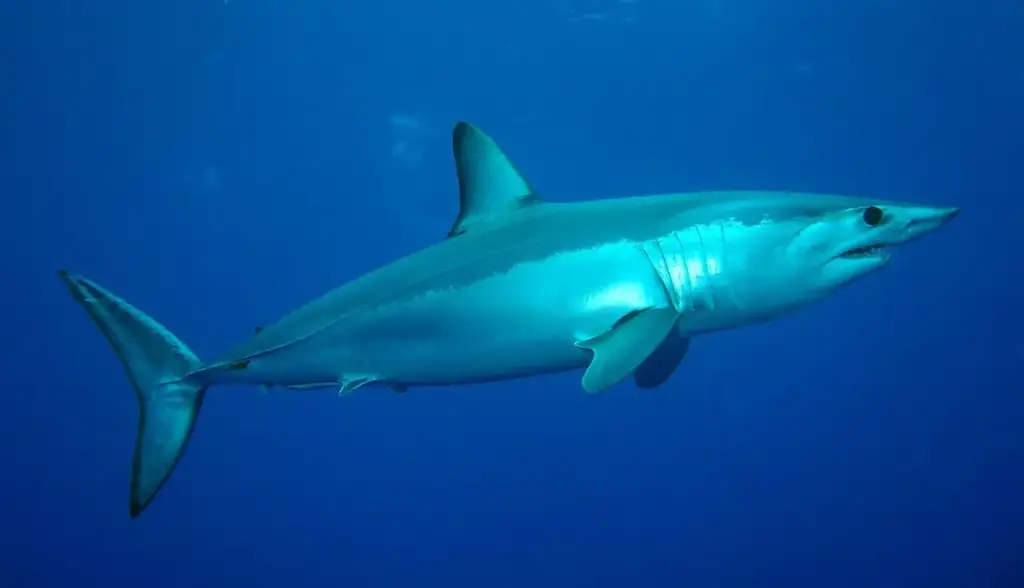
The shortfin mako shark is the cheetah of the ocean, capable of bursts of speed up to 45 mph (72 km/h). These sleek, streamlined sharks can grow up to 13 feet (4 meters) long and are known for their striking blue coloration and impressive leaping ability, sometimes breaching up to 20 feet (6 meters) out of the water.
Makos are active predators, feeding primarily on fast-swimming fish like tuna and swordfish. Their speed and agility make them popular targets for sport fishermen, contributing to population declines. They’re also frequently caught as bycatch in commercial fishing operations. Conservation efforts focus on implementing sustainable fishing practices and protecting critical mako habitats to ensure the survival of these ocean speedsters.
38. Leopard Seal
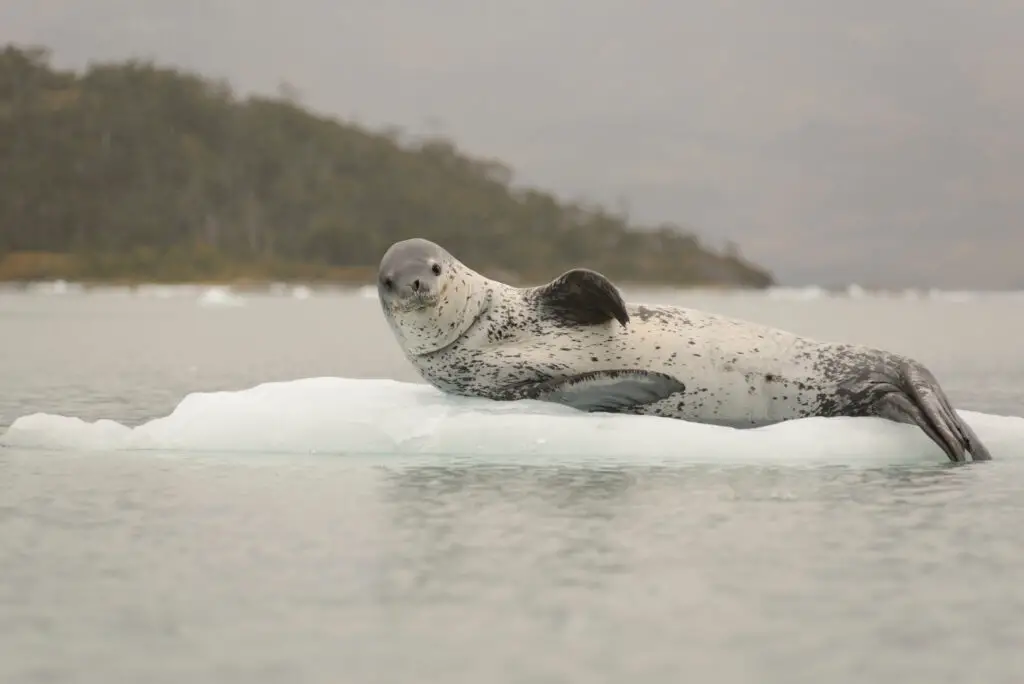
The leopard seal is the Antarctic’s equivalent of a big cat, known for its spotted coat and fearsome reptilian head. Growing up to 11 feet (3.4 meters) long and weighing up to 1,300 pounds (590 kg), these seals are the second-largest species in Antarctica. Their powerful jaws and long, sharp teeth are perfectly adapted for hunting a variety of prey.
Leopard seals are versatile predators, feeding on everything from krill to penguins and even other seals. They’re known for their unique hunting technique of thrashing larger prey at the water’s surface to tear it into smaller, manageable pieces. While not currently threatened, leopard seals face potential risks from climate change affecting their icy habitat. Research and conservation efforts focus on understanding their role in the Antarctic ecosystem and monitoring their population trends.
39. Eurasian Eagle-Owl
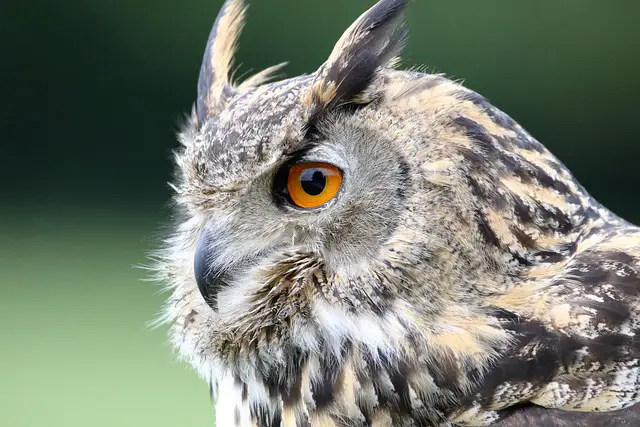
The Eurasian eagle-owl is one of the largest owl species in the world, with a wingspan reaching up to 6.6 feet (2 meters). These impressive birds are found across Europe and Asia, inhabiting a variety of habitats from forests to mountains. Their distinctive orange eyes and prominent ear tufts give them a fierce appearance.
As nocturnal hunters, eagle-owls prey on a wide range of animals, from small rodents to birds as large as herons and even other raptors. Their silent flight and excellent hearing make them formidable nighttime predators. While not globally threatened, these owls face localized threats from habitat loss and human persecution. Conservation efforts focus on protecting their diverse habitats and reducing human-owl conflicts, particularly in urban areas where they sometimes nest.
40. Crowned Eagle
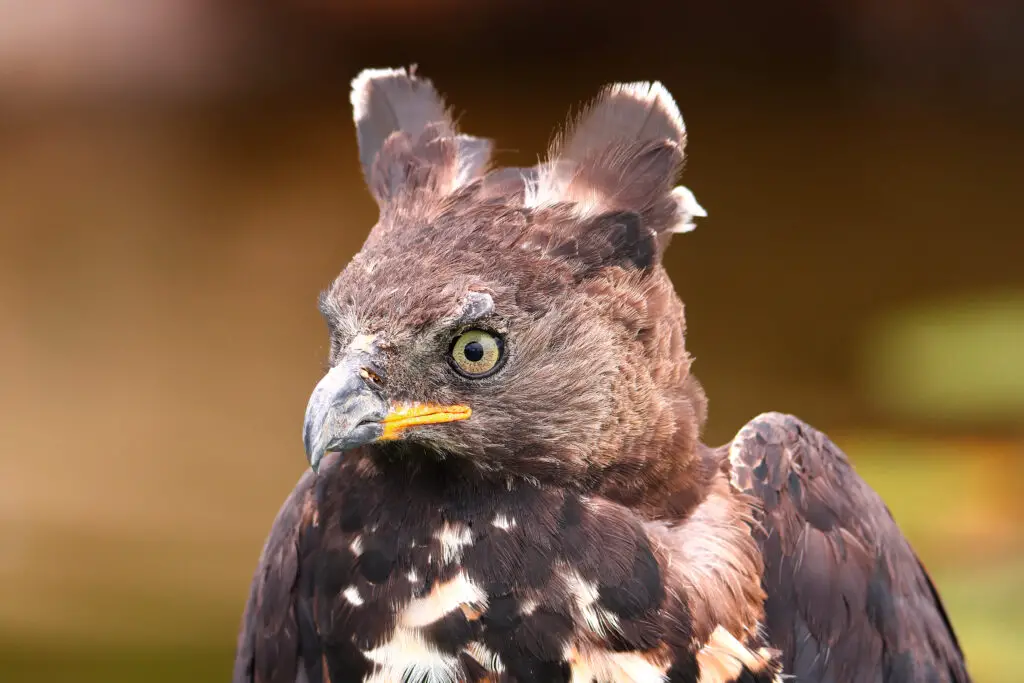
The crowned eagle, often called the “leopard of the air,” is Africa’s most powerful eagle. With a wingspan up to 5.8 feet (1.8 meters), these raptors are known for their strength and agility in forest environments. Their name comes from the distinctive crest of feathers on their head, which they can raise when excited or alarmed.
Crowned eagles specialize in hunting medium-sized mammals, particularly monkeys and small antelopes. They’re capable of taking prey up to their own body weight, using their massive talons to deliver a killing blow. Despite their impressive hunting skills, crowned eagles are near-threatened due to habitat loss as forests are cleared for agriculture. Conservation efforts focus on protecting large tracts of forest and educating local communities about the importance of these apex predators in maintaining ecosystem balance.
41. Martial Eagle
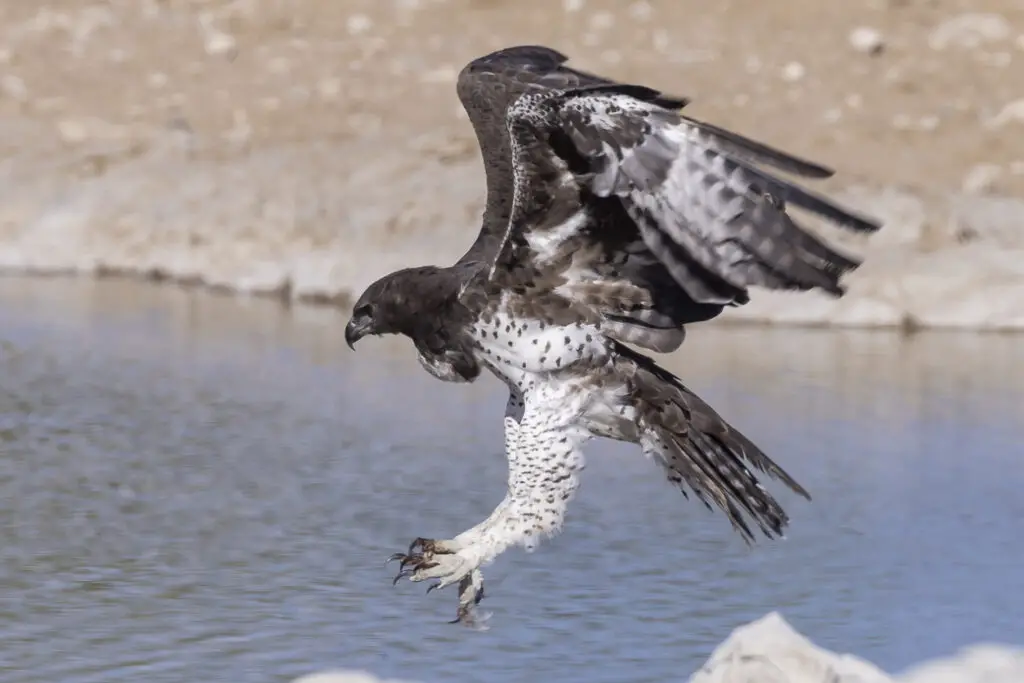
The martial eagle is Africa’s largest eagle, with a wingspan reaching up to 8.5 feet (2.6 meters). These powerful raptors are named for their combative nature and are found across sub-Saharan Africa. Their piercing yellow eyes and dark plumage give them a formidable appearance.
Martial eagles are known for taking on surprisingly large prey, including small antelopes, monkeys, and even young warthogs. Their incredibly strong talons can exert a force of up to 500 psi, allowing them to crush the skulls of their victims. Despite their impressive abilities, martial eagles are vulnerable to extinction due to habitat loss and persecution by farmers protecting livestock. Conservation efforts focus on habitat protection and educating local communities about their ecological importance.
42. African Fish Eagle
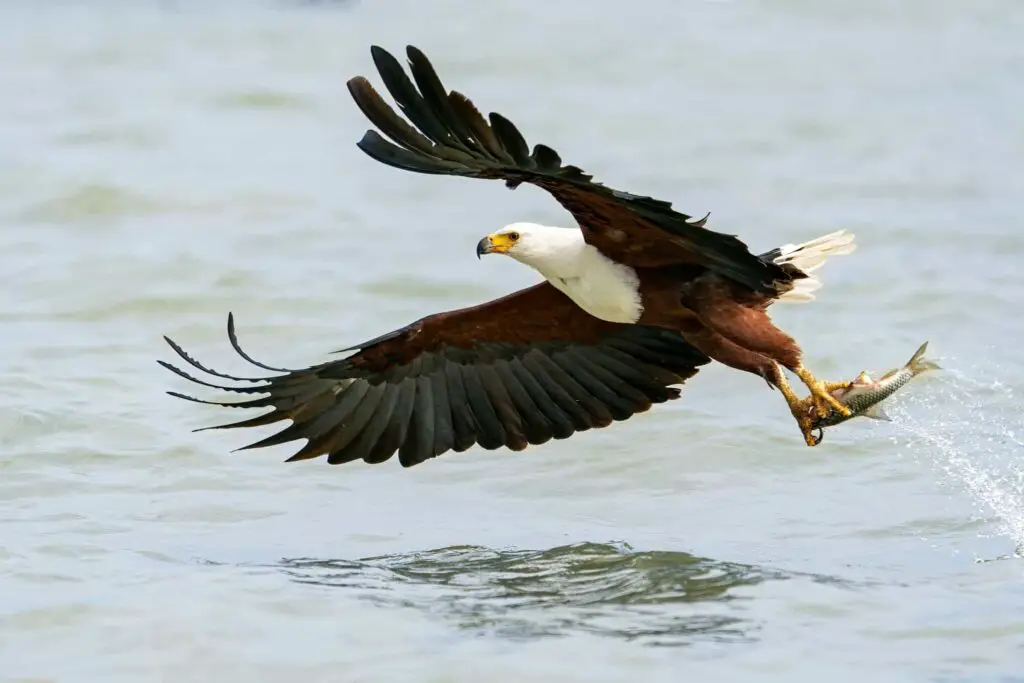
The African fish eagle, with its distinctive white head and chestnut body, is often called the voice of Africa due to its loud, distinctive call. These eagles have a wingspan of up to 8 feet (2.4 meters) and are found near water bodies across sub-Saharan Africa.
As their name suggests, African fish eagles primarily feed on fish, which they snatch from the water’s surface with their powerful talons. They’re also known to prey on flamingos and other water birds. While not currently threatened, these eagles face localized pressures from water pollution and overfishing of their prey. Conservation efforts focus on protecting wetland habitats and maintaining healthy fish populations in their range.
43. Alligator Snapping Turtle
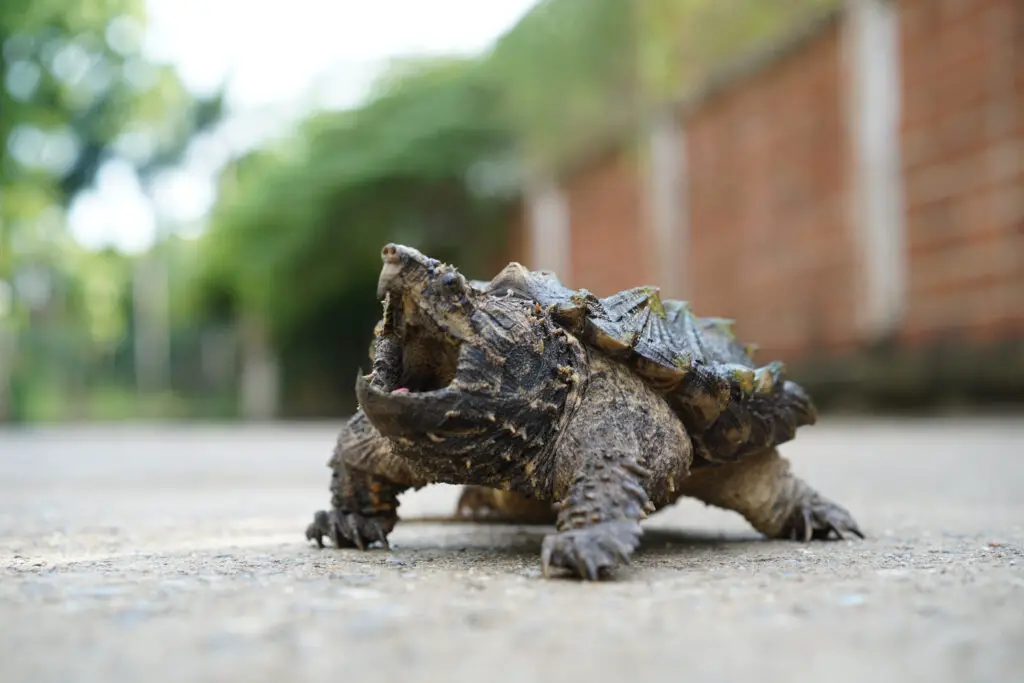
The alligator snapping turtle is North America’s largest freshwater turtle, weighing up to 200 pounds (90 kg). These prehistoric-looking creatures are known for their spiked shells and powerful, hooked beaks. They’re found in the rivers and swamps of the southeastern United States.
These turtles are ambush predators, using a unique lure in their mouth that resembles a worm to attract fish. They’re capable of delivering a powerful bite, earning them the nickname “the dinosaur of the turtle world.” Despite their formidable defenses, alligator snapping turtles are vulnerable to extinction due to overharvesting and habitat loss. Conservation efforts focus on protecting their aquatic habitats and regulating hunting to ensure their survival.
44. Goliath Tigerfish
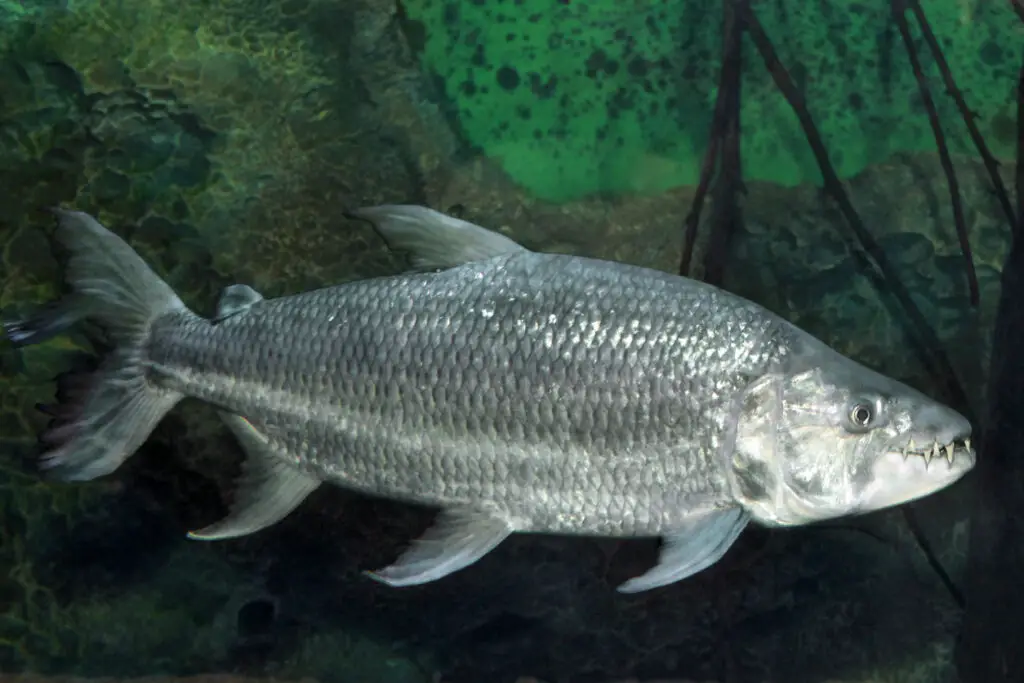
The Goliath tigerfish is the stuff of nightmares, inhabiting the rivers of Central Africa. Growing up to 5 feet (1.5 meters) long and weighing up to 154 pounds (70 kg), it’s the largest member of the tigerfish family. Its mouth is lined with 32 razor-sharp teeth, each up to an inch long, giving it a fearsome appearance.
These powerful predators are known for their aggressive behavior and have been reported to attack humans and even small crocodiles. They primarily feed on other fish, including smaller tigerfish. Despite their ferocious nature, Goliath tigerfish face threats from overfishing and habitat degradation. Conservation efforts focus on protecting their river habitats and implementing sustainable fishing practices.
45. Giant Trevally
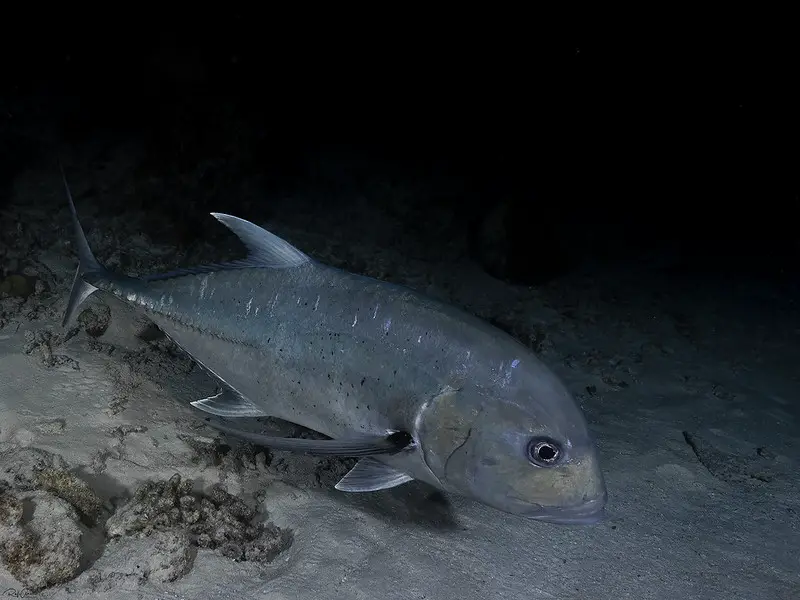
The giant trevally, also known as the ulua, is a formidable predator of coral reefs and open waters across the Indo-Pacific region. These silver-colored fish can grow up to 5.5 feet (1.7 meters) long and weigh up to 176 pounds (80 kg). They’re known for their powerful build and aggressive hunting behavior.
Giant trevallies are apex predators in their ecosystems, feeding on a variety of fish, squid, and crustaceans. They’re famous for their ability to launch themselves out of the water to catch birds in flight. While not currently threatened, they face localized pressures from overfishing and habitat degradation. Conservation efforts focus on establishing marine protected areas and promoting sustainable fishing practices.
46. Humboldt Squid
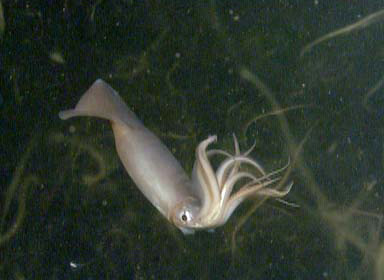
The Humboldt squid, also known as the jumbo squid, is a large, aggressive cephalopod found in the eastern Pacific Ocean. These creatures can grow up to 7 feet (2.1 meters) long and weigh up to 100 pounds (45 kg). They’re known for their intelligence, rapid growth rate, and voracious appetite.
Humboldt squid are formidable predators, using their strong arms and sharp beaks to catch and devour fish and other marine life. They hunt in large groups, communicating through color changes in their skin. While their population is currently stable, they face threats from climate change and overfishing. Research and conservation efforts focus on understanding their role in marine ecosystems and ensuring sustainable management of their populations.
47. Greenland Shark
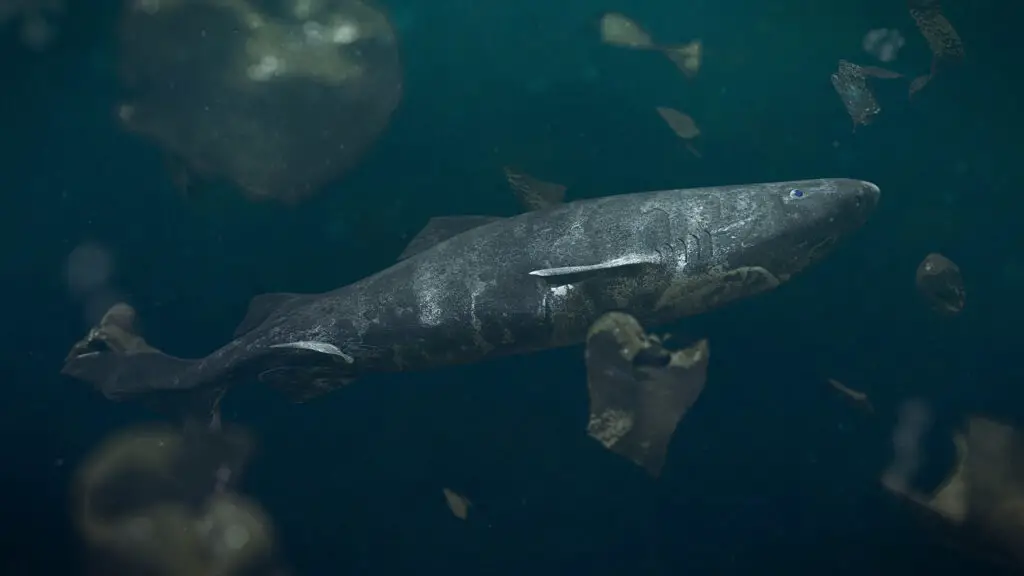
The Greenland shark is one of the largest species of shark, growing up to 24 feet (7.3 meters) long. These slow-moving giants are found in the cold, deep waters of the North Atlantic and Arctic Oceans. They’re known for their longevity, with some individuals estimated to be over 500 years old.
Despite their sluggish appearance, Greenland sharks are apex predators in their ecosystem. They feed on a variety of fish and marine mammals, including seals and smaller sharks. Their flesh contains high levels of trimethylamine oxide, making it toxic to most animals. While not currently threatened, they face risks from accidental capture in deep-sea fishing operations. Conservation efforts focus on reducing bycatch and protecting their deep-sea habitats.
48. Boa Constrictor
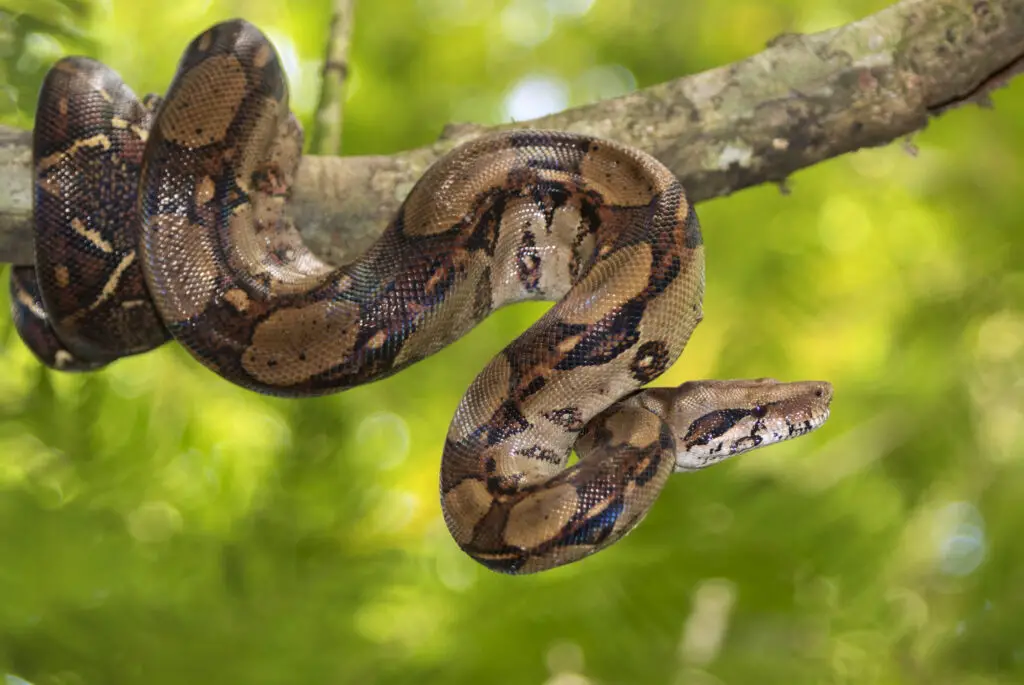
The boa constrictor is a large, heavy-bodied snake found in Central and South America. Growing up to 13 feet (4 meters) long, these powerful constrictors are known for their beautiful patterns and impressive strength. They inhabit a variety of environments, from tropical rainforests to semi-arid regions.
Boas are ambush predators, using their excellent camouflage to surprise prey. They kill by constriction, coiling around their victims and squeezing until suffocation occurs. Their diet includes small mammals, birds, and lizards. While not globally threatened, some boa populations face pressure from habitat loss and the exotic pet trade. Conservation efforts focus on protecting their diverse habitats and regulating the international trade in these impressive reptiles.
49. Andean Condor
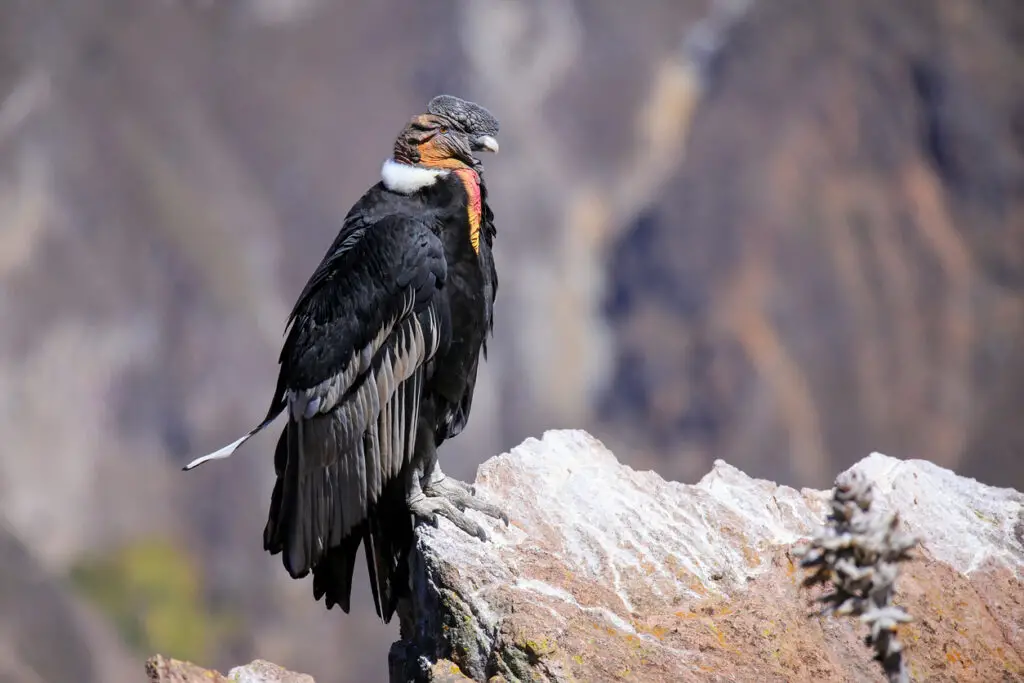
The Andean condor is one of the largest flying birds in the world, with a wingspan reaching up to 10 feet (3 meters). Native to the Andes Mountains of South America, these majestic scavengers play a crucial role in their ecosystem. Males are distinguished by their fleshy comb, which is absent in females.
As nature’s clean-up crew, Andean condors primarily feed on carrion, using their keen eyesight to spot carcasses from great heights. They can go for long periods without eating, then consume up to 15 pounds of meat in one sitting. Despite their important ecological role, Andean condors are near threatened due to habitat loss and persecution. Conservation efforts include captive breeding programs and education initiatives to reduce human-condor conflicts.
50. Harpy Eagle

The harpy eagle, one of the most powerful birds of prey, rules the rainforest canopies of Central and South America. With a wingspan reaching 6.5 feet (2 meters) and weighing up to 20 pounds (9 kg), it’s among the largest eagles in the world. Their legs can be as thick as a small child’s wrist, with talons measuring 3-4 inches (7.6-10.2 cm) long.
Harpy eagles primarily hunt tree-dwelling mammals like sloths and monkeys, capable of carrying prey equal to their body weight. They’re known for their distinctive double crest, which they can raise to create a disc shape, enhancing their hearing. Due to habitat loss from deforestation, harpy eagles are considered near threatened. Conservation efforts focus on protecting large tracts of undisturbed rainforest crucial for their survival and breeding programs to boost their numbers.


